1. Introduction
The EETT Registry of Companies and Licenses (eregistry) is a web application for the management of the following registers:
-
Registry of providers of electronic communications networks and services operating under the general authorization regime.
-
Registry of postal companies operating under general authorization.
-
Registry of postal companies holding an individual license.
-
Registry of intermediary services providers.
-
Registry of domain name registrars.
-
Registry of numbering resources.
The Registry of Companies and Licenses operates in the context of the following EETT decisions:
-
EETT Decision ref: 991/4/ of 17 May 2021 (Government Gazette, Series II, No 2265/2021),
-
EETT Decision ref: 843/2 of 1 March 2018 “Regulation on the Management and Assignment of [.gr] Domain Names or .ελ ” (Government Gazette, Series II, No 973/2018),
-
EETT Decision ref: 966/02 “Regulation on the Management and Assignment of the Numbering Resources of the National Numbering Plan” (Government Gazette, Series II, No 5266/30.11.2020) (correction: Government Gazette, Series II, No 5580/18.12.2020),
-
EETT Decision ref: 686/064/2013 “Regulation on General Authorizations for the Provision of Postal Services” (Government Gazette, Series II, No 1700/10.7.2013),
-
EETT Decision ref: 686/065/2013 “Regulation on Individual Licenses for the Provision of Postal Services” (Government Gazette, Series II, No 1876/31.7.2013),
-
EETT Decision ref: 1086/12 (Government Gazette, Series II, No 6346/Β/6.11.2019),
-
Law ref 5067/2023 "Implementation of the provisions of Regulation (EU) 2021/784 of the European Parliament and of the Council of 29 April 2021 on addressing the dissemination of terrorist content online and other arrangements of the Ministry of Justice." (Government Gazette, Series I, No 189/A/20-11-2023),
-
Law ref 5099/2024 "Measures to implement Regulation (EU) 2022/2065 of the European Parliament and of the Council of 19 October 2022 on a Single Market For Digital Services and amending Directive 2000/31/EC (‘Digital Services Act’) and other provisions." (Government Gazette, Series I, No 48/A/5-4-2024),
-
EETT Decision ref: 1119/2 "Regulation on the operation of the Register of Intermediary Services Providers, including Hosting Services".
The eregistry web application facilitates electronic communications networks and services providers, postal services providers and intermediary services providers to manage the relevant authorizations. Providers submit applications in electronic form, to update the registries provided for in the above regulations. EETT users receive and approve the applications. Approvals are communicated by electronic means.
Instructions are accessible through the help icon. Use of the help icon in the application points to the corresponding section of the instructions.
The user guide is also available in printable format pdf.
2. Overview
2.1. Licenses
Licenses in the context of the eregistry application are the rights acquired by a company to carry out activities, in the fields of electronic communications, postal services and intermediary services. The basic licenses (authorizations) supported by the eregistry are the following:
-
The general authorization for electronic communications.
-
The general authorization for postal services.
-
The individual license for postal services.
-
The right to register domain names (domain names registrar).
-
The provision of intermediary services.
In addition to the authorizations described in the relevant EETT Regulations, the eregistry application also manages a separate authorization, the right to obtain numbers in accordance with the National Numbering Plan (NNP).
2.2. Registry of numbers
The NNP numbers are managed through the eregistry. The eregistry provides the functionality for the management of the NNP and the operations (assignment, revocation, secondary assignment, etc.) of the numbers.
2.3. Applications
The information in the register is updated by submitting applications from the companies concerned, which have access to the application through their representatives (end users). The applications supported by eregistry are the following:
-
Company Registration. The application by which a company is registered on the eregistry web application. Upon approval of the application, the company is registered in the eregistry and a user account and login credentials are created. Following registration, the company may submit applications for obtaining one or more licenses.
-
Electronic Communications General Authorization. The application by which a company applies for registration in the electronic communications networks and services providers registry under the general authorization regime.
-
General Postal Authorization. The application by which a company applies for registration in the Postal Services Providers registry under general authorization.
-
Individual Postal License. The application by which a company applies for registration in the Postal Services providers registry holding an individual license.
-
Domain Name Registrar. The application by which a company applies as a registrar of domain names ending in .gr or .ελ.
-
Provision of intermediary services. The application by which a company notifies EETT about the provision of intermediary services.
-
Numbering. The application by which a company acquires the right to apply for NNP numbers.
To update the registry details, the following applications are also available:
-
Company Modification. The application by which the company may modify its basic information (postal address, representation, contact details, etc.) and inform EETT of the required legal documents provided for in the relevant EETT Regulations.
-
Admin User Registration. The application by which a registered company requests to add a new user with the role of Admin User.
-
Postal Network Modification. By this application, the company may request the modification of the composition of its postal network.
-
Service Modification. Applications relating to the general authorization for electronic communications and postal services, the individual license for postal services and to the provision of intermediary services. By means of this application, a company that has one of the above authorizations may ask for the modification of the services it provides.
-
Representation Modification. Applications pertaining to all types of authorizations. By this application, the update of the contact details and the representatives’ information regarding an authorization is requested.
-
Languages modification. Applications related to licenses to which official languages are declared. With this application, a company which has a license can apply for the modification of the official language(s) of communication.
-
Documents update. Applications pertaining to all types of authorizations. With this application, a company may add or replace documents relating to the license.
-
License Cessation. Application by which the company declares that the activities related to an authorization have ceased.
-
License Activation. Application by which a company applies for the reactivation of an authorization that has been ceased.
-
Fee Exemption. The application by which certified bodies can be exempted from paying fees.
-
Fee Notification. The fee notification is a special type of application, where the company informs EETT for the payment of annual fees (Notification of license fees, Annual number fees notification).
-
Installment Payment. The installment payment is a special type of application where the company informs EETT for the payment of a fee installment under a settlement.
In the field of NNP numbers management, the following applications are available:
-
Number Assignment. By this application, the company applies for the assignment of NNP number blocks.
-
Number Revocation. By this application, a company applies for the revocation of assigned number blocks.
-
Secondary Assignment. By this application, the company applies for the secondary assignment of numbers to another party.
-
Secondary Assignment Transfer. By this application, the company to which the number has been assigned, applies for the transfer of the secondary assignment to another party.
-
Secondary Assignment Removal. By this application, the company requests for the secondary assignment to be removed.
-
Primary Assignment Transfer. By this application, the company requests to receive the primary assignment of another company, following an agreement with the party holding the number on a secondary level.
-
Number Usage Modification. By this application, the company requests that the usage of a number is modified, in cases where the description is necessary.
2.4. Application submission and processing
Applications are submitted and processed online through the eregistry web application. The user with the appropriate role for a specific type of application, is able to enter the details of the request through the eregistry application. Upon completion the application can be submitted. After submission the application gets a unique reference number and it is received by EETT for processing. The application is either approved or rejected. There is also the possibility of sending it back to the company. A typical reason for this is that necessary documents are missing.

| Prior to submitting an application, the eregistry runs an automatic validation to check if it complies with the rules of submission. This function is particularly useful in cases where it is required to pay fees in order to submit the application. |
End users are notified by e-mail about the approval, rejection or forwarding actions regarding their applications.
2.5. User roles
Companies gain access to the eregistry through the end users that they designate. Depending on the role of each user, eregistry grants the relevant rights. The roles of end users available in the eregistry are the following:
-
Admin User. The role that fully represents the company in the eregistry application. The Admin user may, additionally, define new users for the company, assign roles to users (other than the role of Admin), activate and deactivate users. The Admin User is appointed by the legal representative of the company.
-
Company Details Representative. The role which can manage applications related to company data.
-
General Electronic Communications License. The role managing applications pertaining to the general electronic communications authorization.
-
General Postal Services License. The role managing applications pertaining to the general authorization for postal services.
-
Individual Postal Services License. The role managing applications pertaining to the individual license for postal services.
-
Numbering. The role managing applications for the assignment of NNP block numbers.
-
Domain Name Registrar. The role of managing applications relating to the company’s registrar right.
-
Intermediary Services. The role of managing applications relating the provision of intermediary services.
-
Member. A specific role under which the end user has access to the company details in the eregistry web application but has no right to submit and process applications.
| Role | Rights |
|---|---|
Admin User |
Right to full access to company information and the ability to submit and process all types of applications. Right to manage the rest of the company users. |
Company Details Representative |
Right to access the company details. Right to submit applications for the modification of company details. Right to apply for an exemption from paying fees. Right to submit a request for the modification of a postal network. |
General Electronic Communications License |
Right to access the company details. Right to apply for a general authorization for electronic communications. Right to submit applications for modification of the general authorization (Service modification, Representation modification). Right to submit applications for the cessation of activities under the authorization. Right to submit the annual fee information relating to the general authorization for electronic communications. Right to submit an installment payment statement in the context of a settlement. |
General Postal Services License |
Right to access the company details. Right to apply for a general authorization for postal services. Right to submit applications for the modification of the general authorization (Service modification, Representation modification). Right to submit applications for cessation of activities under the authorization. Right to submit annual fee information relating to the general authorization for postal services. |
Individual License for postal services |
Right to access the company details. Right to apply for an individual license for postal services. Right to submit applications for the modification of the individual license (Service modification, Representation modification). Right to submit annual fee information relating to the individual license for postal services. Right to submit applications for the cessation of activities of the license. |
Numbering |
Right to access the company details. Right to submit applications for number assignment, revocation of numbers, secondary assignment of numbers, transfer of secondary assignment, secondary assignment removal, transfer of primary assignment and modification of use of numbers. Right to apply for a numbering right. Right to submit applications to modify the representation of the numbering right. Right to submit applications for the cessation of activities under the numbering right. Right to submit a statement of payment of annual numbering fees. |
Domain Name Registrar |
Right to access the company details. Right to submit applications for the domain name registrar authorization. Right to submit applications to modify the authorization representation. |
Intermediary services |
Right to access the company details. Right to submit applications for the provision of intermediary services. Right to submit applications for modification of provision of intermediary services (Service modification, Representation modification, Languages modification). Right to submit applications for the cessation of activities of the license. |
Member |
Right to access the company details. Right to view all applications in the eregistry. A member may submit a request for registration of an Admin User. |
More than one roles may be assigned to an end user.
2.6. Options menu
The application’s main menu is located on the left side of the page and offers the basic options for reviewing the registry data and submitting applications for updating the registry data.
The main functions of the eregistry are the following:
-
Overview of all applications by selecting
Applications. -
Access to the company’s tasks through the option
Tasks. -
Creation of a new application through the
New Applicationoption. -
Overview of licenses (authorizations) and submission of modification applications through the
Licensesoption. -
Overview of fees invoices through the selection
Fees. -
Management operations through the
Profileoption.
2.7. Tasks
To make any changes in the registry, the relevant application must be submitted and approved. Applications are submitted by the end users of the company and processed by EETT staff, following the request processing flow. During each application’s processing, a set of actions are performed. Actions are carried out by the EETT staff and the end users of the company.
Applications are processed by the EETT staff after submission. Throughout the processing, three options are available:
-
Approval of application and registry update.
-
Rejection of application.
-
Send back a request to the applicant in order to provide additional information. The application is sent back, mainly, in case of missing documents. Applications for number assignment are also sent back in the case of fee payments.
After an application is submitted, the participation of the end users of the company shall pertain to the completion of the returned applications and to forwarding them anew to EETT. In all actions performed in the context of an application, the eregistry informs the end user of the company by e-mail.
The pending tasks of a company with regard to the submitted applications
fall into two categories:
Unassigned tasks, namely the pending tasks
of the company which have not been assigned to end users of the company,
and Pending Tasks, namely the personal pending tasks of each end user.
All company tasks that include unassigned and pending tasks, are available through
the Tasks/All Tasks option.
2.7.1. Unassigned Tasks
Unassigned tasks are tasks regarding the company applications that are
pending and have not been assigned to an end user.
The table of unassigned tasks is displayed by clicking on the
icon at the top of the page or by selecting the
Tasks/Unassigned option of the main menu.
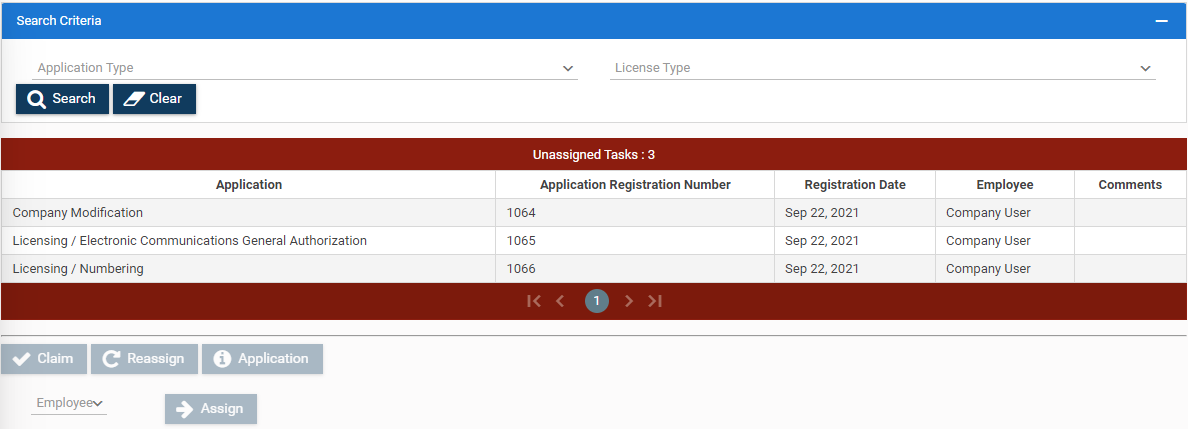
The Unassigned Tasks page displays all tasks that are not assigned to an end user. The unassigned tasks page provides search criteria such as the application type and the license type. In addition to the basic information of the application, the list of unassigned tasks also displays the end user who handled the application in the past (if applicable) as well as comments related to the task.
Tasks can be assigned to an end user of the
company depending on the type of application
and the role of the user.
There are two ways to assign a task.
Either the user claims the task by
clicking Claim or the user
who has the Admin User role assigns the task by selecting a
user from the list of the end users
of the company and clicking Assign.
Upon Assigning, the task shall be transferred to the
list of pending issues of the end user.
If a task appears in the list of unassigned tasks and it is already handled by a user,
it is possible to Reassign it to the same user.
2.7.2. Pending Tasks
Pending Tasks are uncompleted tasks
assigned to an end user and should be carried out.
The table of pending tasks is displayed by clicking on the
icon at the top of the page,
or by selecting Tasks/Pending Tasks in the main menu.

When selecting the Process option,
the task processing page is displayed.
The basic options for processing a task are the following:
-
Reassigning the task: The
Reassignoption transfers tasks to unassigned tasks, so that they may be assigned to another user of the company. -
Attaching a document: It is possible to attach a document to the application pertaining to the specific task.
-
Forwarding the application to EETT: The application is forwarded to EETT to resume processing.
-
Payment of fees: Particularly for number assignments requests (Number assignment, Secondary assignment, Primary assignment transfer), it is possible to enter the fee payment information.
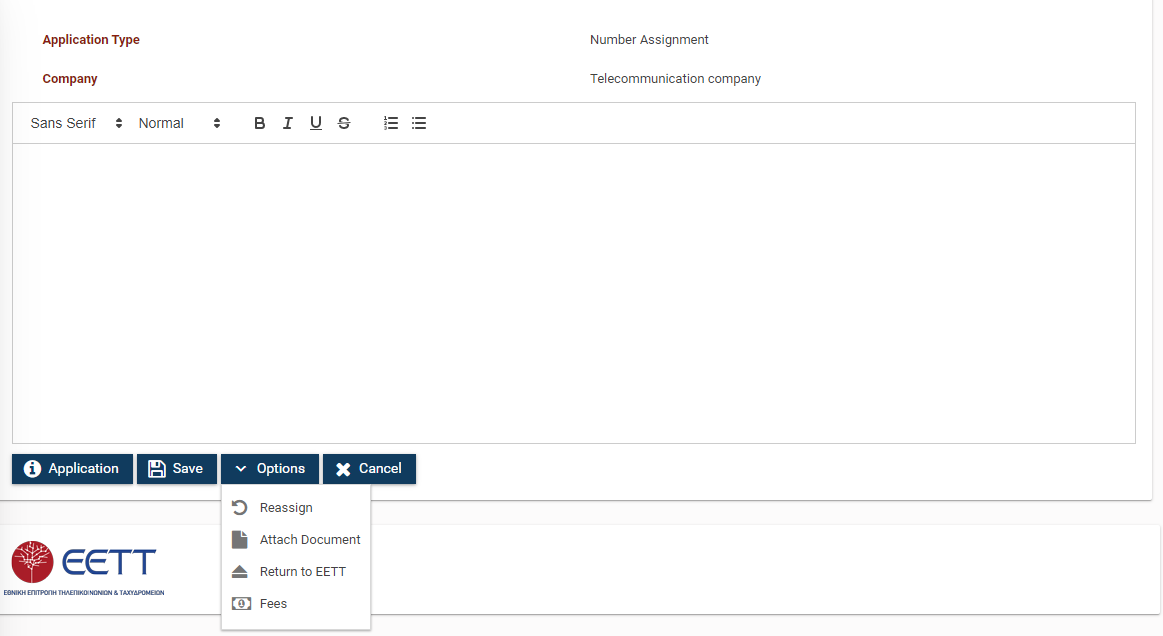
Additionally, it is possible to enter comments related to the task. The comments are communicated to the EETT user who will receive the application and are also recored in the application action history.
2.7.3. All Tasks
All company’s pending tasks are displayed in the main
menu under the Tasks/All Tasks option.
The table includes all unassigned tasks as well as tasks
assigned to users of the company.

Users with the role of Admin User are able to
cancel the assignment of a task to an end user via the Reassign option.
Upon cancellation of the assigning process,
the task is transferred to the unassigned tasks.
3. Company registration
New companies register online for the registry of companies through the eregistry web application. Prior to registration of a new company aiming to operate in the areas of electronic communications and/or postal services and/or intermediary services, a preliminary check is carried out to examine if EETT has been informed about the company in the past. The registration process appears in the figure below.
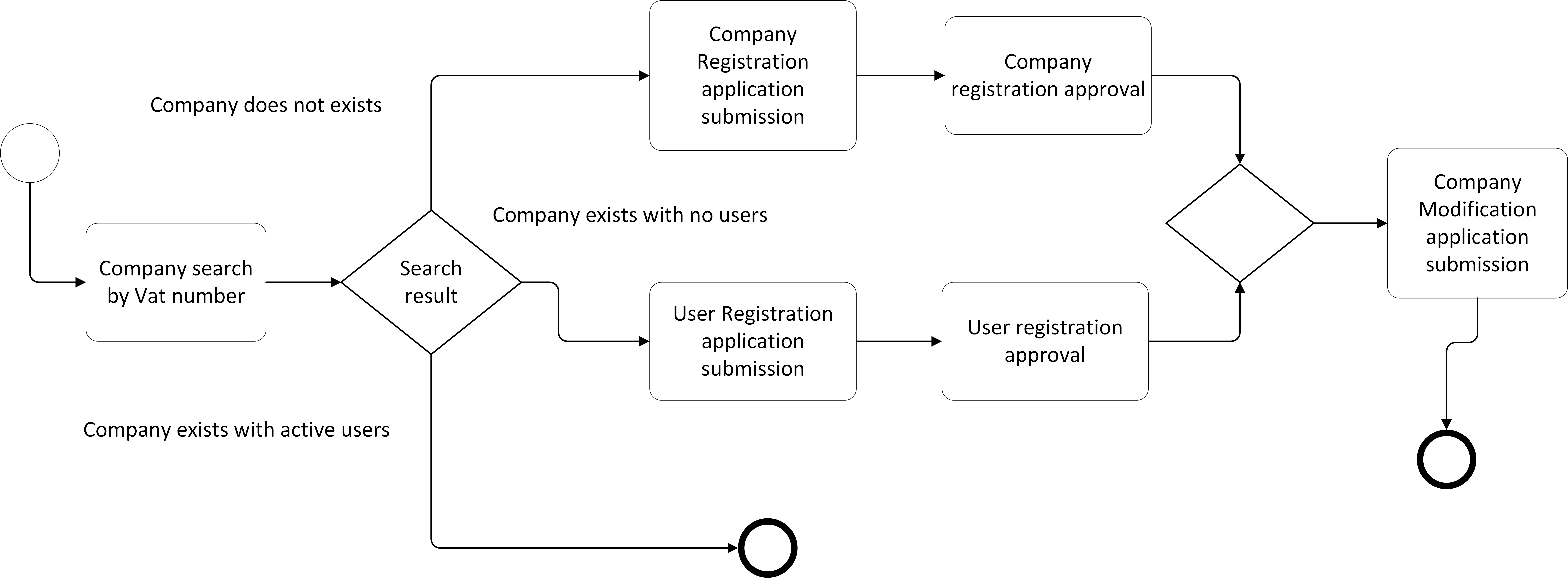
In order to register a company, it must first be examined whether the company already exists in the registry (although this does not mean that it is registered in the authorization registries) and whether the company has users. For the successful registration of the company, its basic information and the appointment of a person with the role of Admin User are required, so that this person can sign in as the company’s representative.
The registration process starts with the Company Registration
option on the main page of the application.

Enter the vat number of the company and the country where it operates,
and select Search.
The search may produce three possible results, as follows:
-
The company does not appear in the company registry. The system allows you to submit a company registration application by clicking
Register New Company. -
The company appears in the company registry with active users. No company registration is required.
-
The company appears in the company registry without active users. The eregistry allows the registration of an Admin User. The
Register Administratoroption allows the submission of the application for Admin user registration.
In case the company does not appear in the registry, the company data and the basic details of the Admin User should be entered. A copy of the two sides of the id card or of the passport of the Admin User should be attached to the request, in digital form.
| The e-mail address will be used as the username of the newly created user account. |
The designated Admin user is informed of the approval of the application by an e-mail sent to the indicated address. In the same e-mail, the password to login to the eregistry and a pre-filled Admin form (in pdf format) are also sent.
Upon receipt of the password it is possible to login to the eregistry as a company representative (Admin user). The next step is to submit an application for the modification of company details in order to be able to apply for registration in the electronic communications and/or postal services and/or domain name registries and/or intermediary services. To do this you must login to the eregistry and submit an application for the modification of company details (Company modification). To submit the application, it is required to attach thereto the legal documents pertaining to the company and the pre-filled Admin Form received in the registration approval e-mail, signed by the legal representative of the company.
4. Application management
4.1. Application list
The Applications option in the main menu, presents the list of applications
created by the company.
Through the list of applications, it
is possible to edit, view and submit applications.
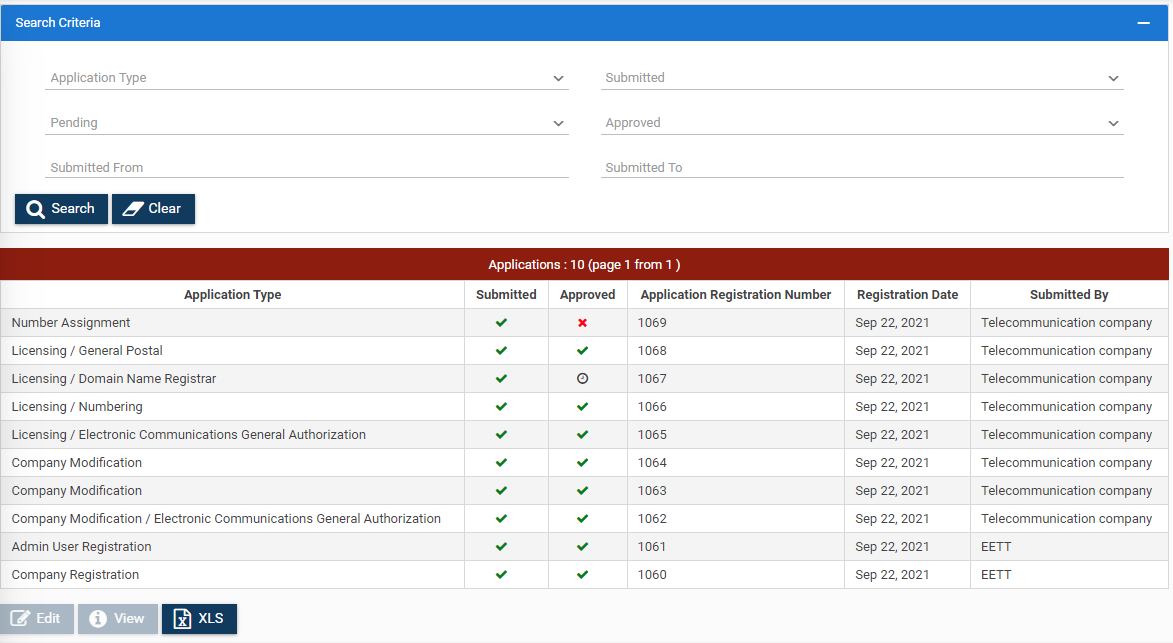
A set of search criteria are provided to facilitate searching the list:
-
Application Type: Select one of the various types of applications.
-
Submitted: Select whether you wish to search for submitted or non-submitted applications.
-
Pending: Select if you wish to limit the results to pending applications.
-
Approved: Select if you wish to limit the results to approved applications.
-
Submission range: The
Submitted fromandSubmitted tofields specify the range of dates within which the application was submitted. -
Document type: Select if you want to limit the list results to applications that have a specific type of document attached.
The list shall display the applications that meet all the search criteria.
Upon selection of the View button, the details of the selected application
shall be displayed. Upon selection of the Edit button,
the request processing page shall be displayed.
The Edit button is available in cases where the application has
not been submitted and where your role gives you the right to edit.
| The right to view an application is granted to all active users of the company. The right to edit is granted only to users with a relevant role. Admin Users have full access to all applications. |
4.2. View application
It is possible to view the details of each application in the eregistry. These details may vary depending on the type of application. Common elements included on the View page of each application are the following:
-
The documents of the application, which can be downloaded via the icon.
-
Comments about the application.
-
Application Log: Shows the actions that have been performed from the submission of the application until its processing completion. It also shows the comments made during the processing, especially in the cases of rejection and return.
The page for viewing the application provides the capability to
immediately revoke a submitted application. It is applicable to all pending applications,
via the Revoke button.
|
4.3. Company modification
The application for the modification of company details pertains to the update of the basic data of the company, representation thereof, as well as the update, in digital form, of all the necessary legal documents.
This application shall be submitted for the first time following the registration of a new company in the registry.
| Where the application follows the registration of a new company, the signed Admin Form must be included in the attached documents. |
In order to submit an application for intermediary services you need to have registered the company’s Legal Representative (who must have a VAT number and an ID/passport number), the company’s website and the company’s size. It is reccomended to enter the aformentioned information and submit the company modification application, prior to the submission of an application for the Provision of intermediary services.
The size of the company is defined according to the Recommendation 2003/361/EC on the basis of the financial amounts and the staff headcount of the enterprise under registration of the latest approved accounting period (calculated on an annual basis), as follows:
-
Microenterprise: an enterprise which employs fewer than 10 persons and whose annual turnover and/or annual balance sheet total does not exceed EUR 2 million.
-
Small enterprise: an enterprise which employs fewer than 50 persons and whose annual turnover and/or annual balance sheet total does not exceed EUR 10 million and does not fall into the category “microenterprise”.
-
Medium-sized enterprise: an enterprise which employs fewer than 250 persons (but more than 49) and which has an annual turnover not exceeding EUR 50 million, and/or an annual balance sheet total not exceeding EUR 43 million and does not fall into the category “microenterprise” or “small enterprise”.
-
Other: an enterprise that does not fall into the category “microenterprise”, “small enterprise” or “medium enterprise”.
For more information please consult the text of the Recommendation 2003/361/EC.#
New applications are generated through the New Application/Company Modification menu option.
The application shall contain the current
details of the undertaking together with the current certifying documents.
Via the application you can modify the basic details of the company, modify the representation details delete a certifying document that has ceased to be valid or add another document.
The legal documents required depending on the legal form of the company are the following:
(A) Legal Entities / Natural Persons established / residing in Greece
-
Natural Persons
-
Police ID Card or passport.
-
Stay and work permit, if the person is an alien.
-
Professional activity commencement certificate issued by the competent Tax Office.
-
-
ΙΚΕ – ΕΕ- ΟΕ- ΑΕ - ΕΠΕ
-
The Company’s Articles of Association and Amendments thereto, or a decision of the BoD or minutes of the general meeting of the partners, duly published, on the legal representation of the company and authorization to legal representatives.
-
Latest certificate issued by GEMI on the non-dissolution and/or amendments to the company.
-
(B) Legal / Natural persons based / residing in a Member State of the European Union
-
Legal Persons
-
Documents certifying the incorporation and representation of the foreign legal entity accompanied by apostille and an official translation in the Greek language by Greek attorney or the Translation Office of the Ministry of Foreign Affairs.
-
-
Natural Persons
-
Copy of ID Card or Passport.
-
Certificate of tax registration for the commencement of business by the competent tax authority.
-
Certificate/Document of the competent tax authority stating the tax registration number/ certifying the tax registration number.
-
(C) Companies NOT established in the EU or the European Economic Area. It is specified that companies that are not established in the European Union or the European Economic Area, must also submit the relevant document issued by the competent Greek tax authority certifying they have taken all necessary actions/have provided all required notifications to that Authority in order to start providing electronic communications networks and/or services. Any statement which does not meet the above requirements shall be automatically filed.
4.4. Admin user registration
A registered company should have at least one user with the role of Admin User.
The Admin User may define new users and assign roles to them. However, he/she cannot appoint a new user as Admin.
A new user may be appointed as Admin User by the New Application/Admin User Registration
option of the main menu.
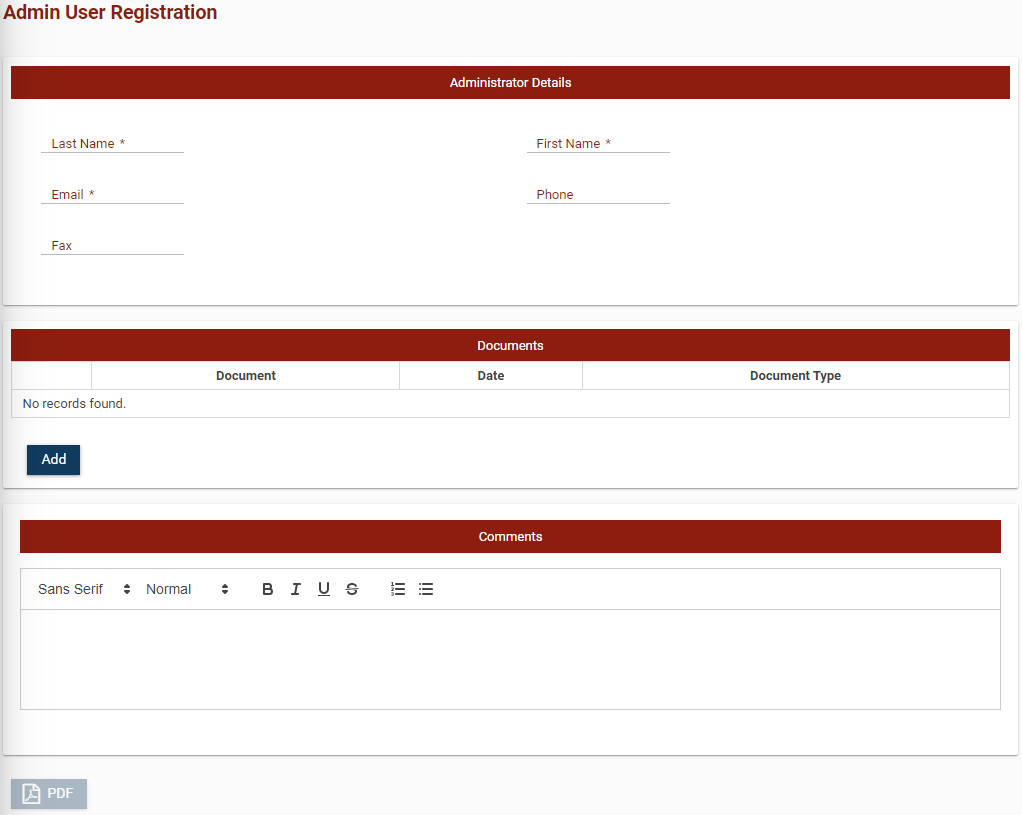
By this application, the main details of the user shall be filled in,
with particular emphasis on the e-mail address,
which is used as the username.
The eregistry automatically generates the electronic file of the
registration application through the PDF option.
The document produced should be signed by the legal representative.
It should also be attached to the application prior to submission.
| Admin User registration is an application that can be submitted by all company users regardless of their role. |
4.5. General authorization for electronic communications
In order to apply for registration in the electronic communications networks
and services registry under the general authorization regime,
you should create and submit a general authorization application
through the New application/New License/General Electronic Communications
option of the main menu.
| If the menu option for creating an application for a general electronic communications authorization does not appear, you should first apply for the modification of company details. |
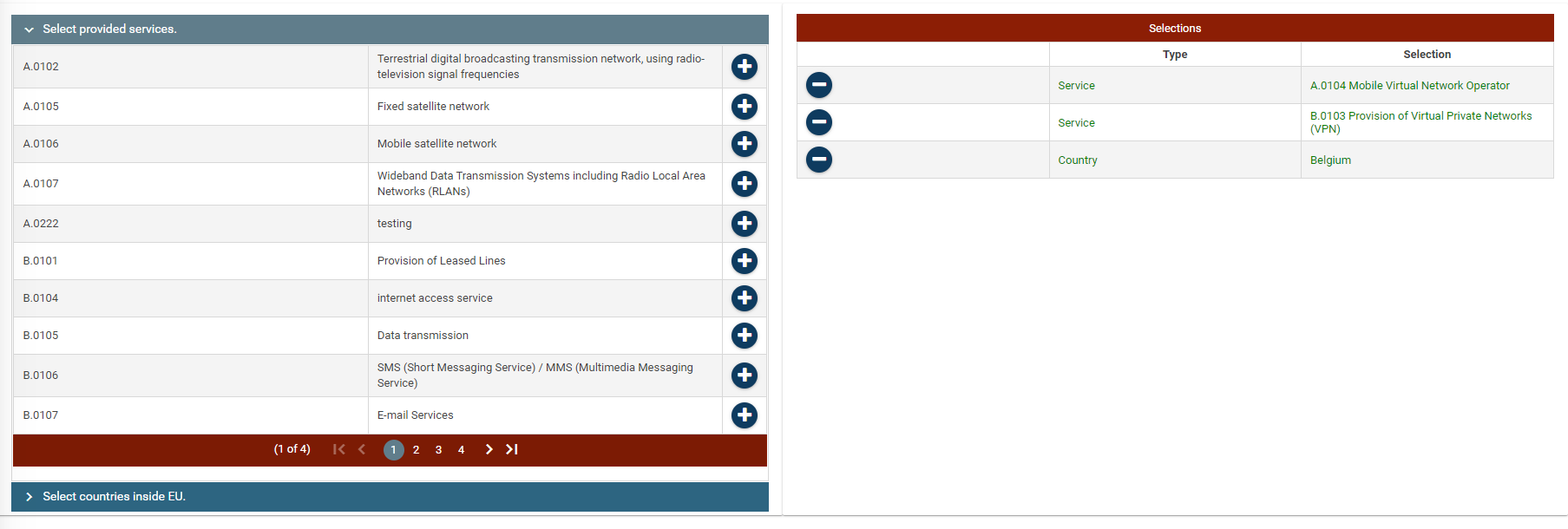

The information to be filled in is the following:
-
Effective date. The start date for the specific activity.
-
Public contact address. The eregistry application creates the public contact address by copying the address data of the company. They can be modified specifically for the general authorization.
-
Contact Details. The contact details (telephone, email, fax) specifically for the general electronic communications license.
-
Representation in the form of contact details especially for the general authorization. In addition to the details of the representatives, branches of the company within the EU can also be entered.
-
Services to be provided. The services are selected from the
Select provided servicespanel by clicking on the icon. The requested services appear in theSelectionspanel. A requested service may be removed by clicking on the icon. -
Countries inside EU. The countries of establishment are selected from the
Select countries inside EUpanel by clicking on the icon. The counties appear in theSelectionspanel. A country may be removed by clicking on the icon.
To submit an application for a general authorization for electronic communications, the relevant fees must be paid first. You need to fill in the fee payment information.
To avoid problems when submitting the application,
click the Validation button before paying the fees.
|
By selecting Submit, the application is
submitted and processed by EETT.
| In case your company provides electronic communications services to other countries within the EU, you can declare these countries through a new application for representation modification. |
4.6. General authorization for postal services
In order to apply for registration in the registry of postal services providers
under general authorization, you should create and submit a
general authorization request through the New Application/New License/General Postal
option of the main menu.
| If the menu option for creating an application for a general authorization for postal services does not appear, you should first apply for the modification of company details. |

The information to be filled in is the following:
-
Public contact address. The eregistry application creates the contact address by copying the address data of the company. They can be modified specifically for the general authorization.
-
Contact Details. The contact details (telephone, email, fax) specifically for the general authorization.
-
Representation in the form of contacts details especially for the general authorization.
-
Services to be provided. The services are selected from the
Select provided servicespanel by clicking on the icon. The requested services appear in theSelectionspanel. A requested service can be removed by clicking on the icon.
To submit an application for an individual license for postal services, the relevant fees must be paid first. You need to fill in the fee payment information.
To avoid problems when submitting the application,
click the Validate button before paying the fees.
|
By selecting Submit, the application is submitted
and processed by EETT.
4.7. Individual License for postal services
In order to apply for registration in the registry of postal services providers holding an Individual License,
you should create and submit an Individual License request
through the New Application/New License/Individual Postal
option of the main menu.
| If the menu option for generating an application for an Individual License for postal services does not appear, you should first apply for the modification of company details. |

The information to be filled in is the following:
-
Public contact address. The eregistry creates contact details by copying the address data of the company. They can be modified especially for the Individual License.
-
Contact Details. The contact details (telephone, email, fax) specifically for the Individual License.
-
Representation in the form of contacts details especially for the Individual License.
-
Services to be provided. The services are selected from the
Select provided servicespanel by clicking on the icon. The requested services appear in theSelectionspanel. A requested service can be removed by clicking on the icon.
To submit an application for an individual license for postal services, the relevant fees must be paid first. You need to fill in the fee payment information.
To avoid problems when submitting the application,
click the Validate on button before paying the fees.
|
By selecting Submit, the application is submitted and processed
by EETT.
4.8. Domain names registrars
To register as a domain names registrar, you must create and submit an application
through the New Application/New License/Domain Name Registrar option of the main menu.
Registration as a domain names registrar is not a formal authorization issued by EETT.
The application shall play the role of registrar notification
in accordance with the relevant EETT regulations.
| If the menu option for generating an application for a domain name registry authorization does not appear, you should first apply for the modification of company details. |
The information to be filled in is the following:
-
Public contact address. The eregistry application creates the public contact address by copying the address data of the company. They can be modified especially for the domain name registrar authorization.
-
Contact Details. The contact details (telephone, email, fax) specifically for the domain name registrar authorization.
-
Details of representatives especially for the domain name registrar authorization.
To avoid problems when submitting the application,
click the Validate button before submitting.
|
By selecting Submit, the request will be submitted and
processed by EETT.
| Approval of the application shall suspend the authorization. The procedures for registration in the domain names registry (https://grweb.ics.forth.gr/) should be completed in order to remove the suspension by EETT. |
4.9. Numbering right
The numbering right must precede the application for the assignment of numbers of the National Numbering Plan. It is not a formal authorization provided by relevant EETT regulations, but a preliminary approval given to companies to submit applications for number assignments.
The right can be granted to companies that have a general electronic communications authorization. It can also be granted to entities without general authorization, falling into the following categories:
-
providers of state networks, where the services or the network they provide justify the use of the requested numerical resources,
-
Dioceses and bodies registered in the National Register of Private-Sector Non-Profit Bodies providing social care services in accordance with the provisions of Law 2646/1998,
-
legal persons governed by private law, which have been certified by a relevant decision of the competent Minister, as non-profit social care providers and which operate and have in place control mechanisms throughout Greece in accordance with Article 67(1) of Law 4313/2014;
-
any company, even if it does not operate under a general authorization regime, for series 4 numerical resources.
| The above does not apply to the assignment of numbers which correspond to multimedia information services, where operators should have general authorization regarding the service. |
To obtain the numbering right, you must create and submit an application through
the New Application/New License/Numbering option of the main menu.
| If the menu option for generating an application for a numbering right authorization does not appear, you should first apply for the modification of company details. |
The information to be filled in is the following:
-
Public contact address. The eregistry application creates contact details by copying the address data of the company. They can be modified specifically for the numbering right.
-
Contact Details. The contact details (telephone, email, fax) specifically for the numbering right.
-
Details of representatives specifically for the numbering right.
By selecting Submit, the application is submitted
and processed by EETT.
4.10. Provision of intermediary services
In order to apply for registration in the registry of the intermediary services providers,
you should create and submit an Individual License request
through the New Application/New License/Intermediary Services
option of the main menu.
| If the menu option for generating an application for the provision of Intermediary Services does not appear, you should first apply for the modification of company details. |
In order to submit an application for intermediary services you need to have registered the company’s Legal Representative (who must have a VAT number and an ID/passport number), the company’s website and the company’s size. If the aformentioned information has not been registered, you should first apply for the modification of company details.
The size of the company is defined according to the Recommendation 2003/361/EC on the basis of the financial amounts and the staff headcount of the enterprise under registration of the latest approved accounting period (calculated on an annual basis), as follows:
-
Microenterprise: an enterprise which employs fewer than 10 persons and whose annual turnover and/or annual balance sheet total does not exceed EUR 2 million.
-
Small enterprise: an enterprise which employs fewer than 50 persons and whose annual turnover and/or annual balance sheet total does not exceed EUR 10 million and does not fall into the category “microenterprise”.
-
Medium-sized enterprise: an enterprise which employs fewer than 250 persons (but more than 49) and which has an annual turnover not exceeding EUR 50 million, and/or an annual balance sheet total not exceeding EUR 43 million and does not fall into the category “microenterprise” or “small enterprise”.
-
Other: an enterprise that does not fall into the category “microenterprise”, “small enterprise” or “medium enterprise”.
For more information please consult the Recommendation 2003/361/EC.

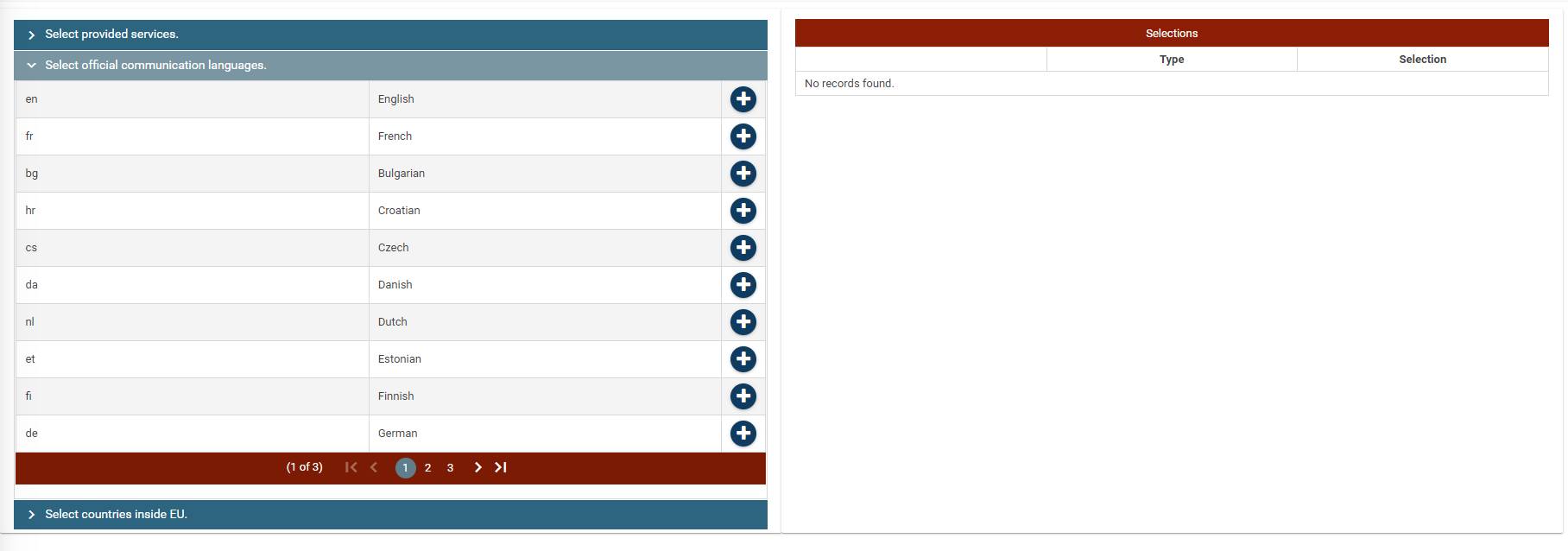
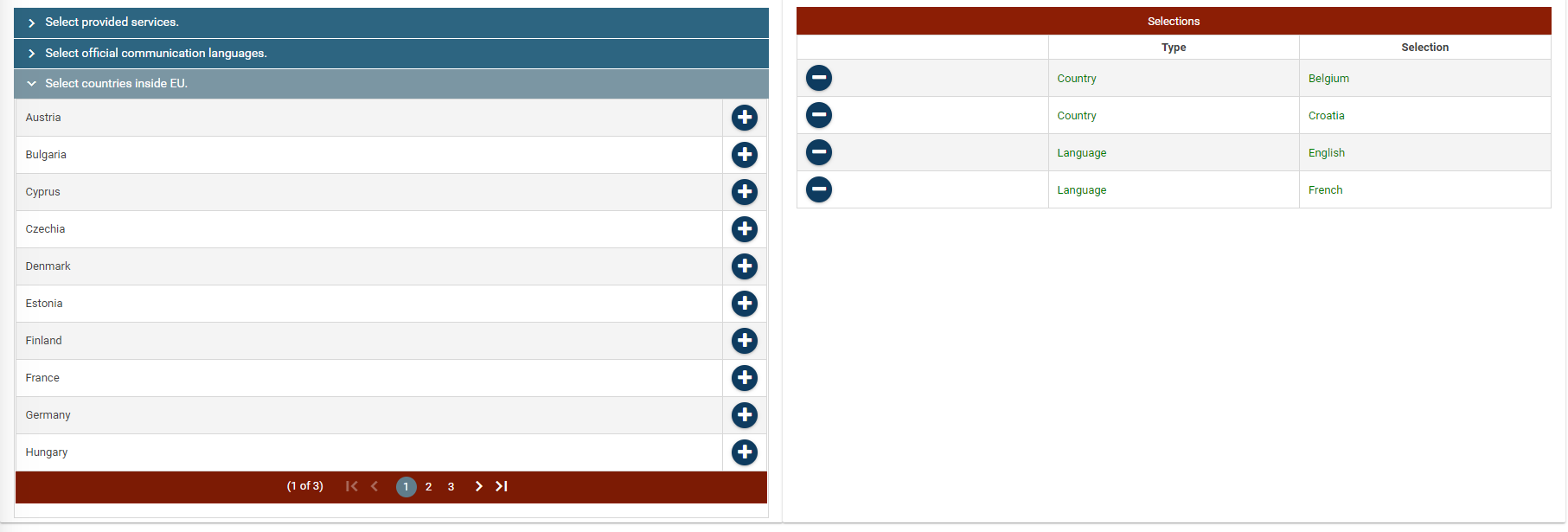
The information to be filled in is the following:
-
Services to be provided. The services are selected from the
Select provided servicespanel by clicking on the icon. The requested services appear in theSelectionspanel. A requested service may be removed by clicking on the icon. -
Official communication languages. The languages are selected from the
Select communication languagespanel by clicking on the icon. The selected languages appear in theSelectionspanel. A selected language may be removed by clicking on the icon. -
Countries inside EU. The countries of establishment are selected from the
Select countries inside EUpanel by clicking on the icon. The counties appear in theSelectionspanel. A country may be removed by clicking on the icon. -
Public contact details. The eregistry application creates public contact details by copying the address data of the company. They can be modified specifically for the provision of intermediary services.
-
Contact Details. The contact details (telephone, email, fax) specifically for the provision of intermediary services.
-
Representation in Greece in case of a company outside Greece. In this case you will have to choose if the Representative in Greece is a Natural or a Legal Person. In case of a Natural Person you will have to register his/hers contact details, along with his/hers VAT number and ID/Passport number. In case of a Legal Person you will have to register the Legal Person’s information and the Legal Person’s Representative details (VAT number and ID/Passport Number included).
-
Representation in the form of contact details especially for the provision of intermediary services. #
| For the provision of intermediary services, it is mandatory to declare (a) Contact persons for communication with the public (b) Point of contact for crisis management and (c) Point of contact with Member States' authorities, the Commission and the Board. Specifically for the provision of hosting services, a contact point for the receipt of removal orders for terrorist content should also be declared. Only the e-mail address and the telephone number are requested for the contact point. It is not possible to submit the application without stating the specific types of contact point. |
To avoid problems when submitting the application,
click the Validate button before submitting.
|
By selecting Submit, the application is submitted
and processed by EETT.
4.11. Fee Exemption
Legal persons governed by private law which have been certified by a relevant decision of the competent Minister as providers of non-profit social care services and which operate and have in place control mechanisms throughout Greece, are exempted from the obligation to pay fees to EETT, in accordance with Article 67(1) of Law 4313/2014. Certified bodies should submit an application for exemption from fees.
The application for fee exemption is created through the New Application/Fee Exemption option
of the main menu.
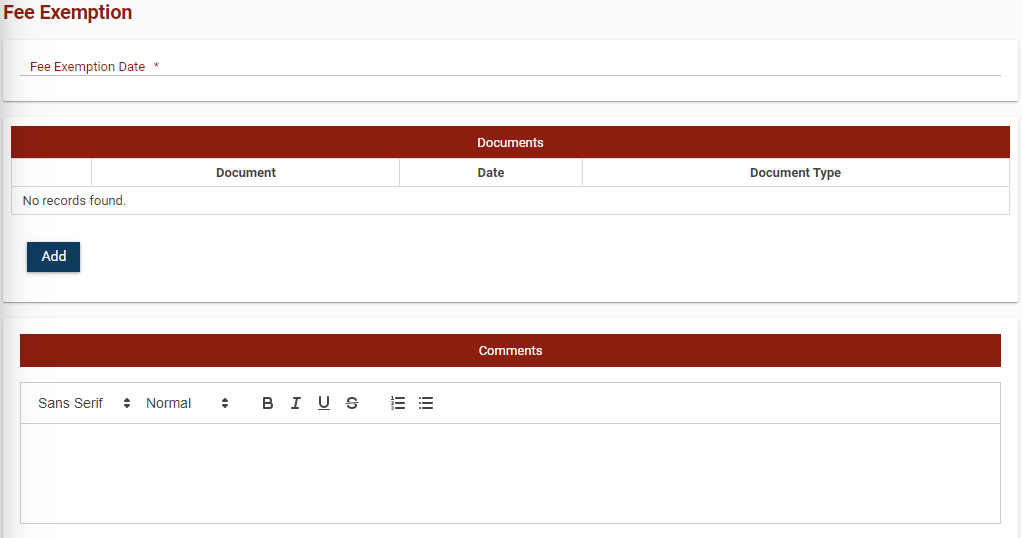
You need to fill in the expiry date until which you have been exempted from fees, according to the certification you have received. The attached documents should include: (a) the relevant certifying Government Gazette; and (b) a solemn declaration that the body operates and has in place control mechanisms throughout Greece.
| The application for fee exemption must precede the applications for which fees are to be paid. |
| The display of the current expiry date of the exemption from fees is available on the company profile page. |
5. License management
Through the Licenses option of the main menu, the company’s authorizations are displayed.
You can display the details of each license (i.e. authorization) through the View option.

It is also possible to navigate the history of the license. Depending on the type of license you may submit an application for:
-
the modification of the license services.
-
the modification of the license representation.
-
the official communications languages modification.
-
the update of documents of the license.
-
the declaration of cessation of activities under the license.
-
the activation of the license, in case of prior cessation of activities.
The option to create modification applications is provided by the Options button
for a selected license.
5.1. Service modification
A service modification application pertains to specific authorizations for which services are declared (general authorization for electronic services, general authorization for postal services and individual license for postal services).

To create a service modification application,
you must display the list of company authorizations
through the Licenses option of the main menu.
Then, you need to select the authorization in which you are interested and select,
in Options, the Service Modification option.
The application shows the services appearing in the Services panel.
You may add a new service through the icon in the Available Services panel,
or remove a service through the icon in the Services panel.
In the event that a fee is required to submit an application,
you must also fill in the fee payment information.
After filling in the application, you can submit it for processing by EETT.
5.2. Representation modification
To update the details of the representation of a license (i.e. authorization) you
must submit the appropriate application. To create a representation modification application,
you must display the list of company authorizations through the Licenses option of the main menu.
Then, you need to select the authorization in
which you are interested and select, in Options,
the Representation Modification option.
In the application you may edit:
-
Communication information for the consumers.
-
Details of representatives and contact points where appropriate.
Especially for the general authorization for electronic communications and the provision of intermediary services, any activities in EU countries can also be declared through this application. In addition, for the general authorization for electronic communications any branches of the company in EU countries may be indicated.
After filling in the application, you may submit it for processing by EETT.
5.3. Languages modification
In order to update the official communication languages you must submit the appropriate application.
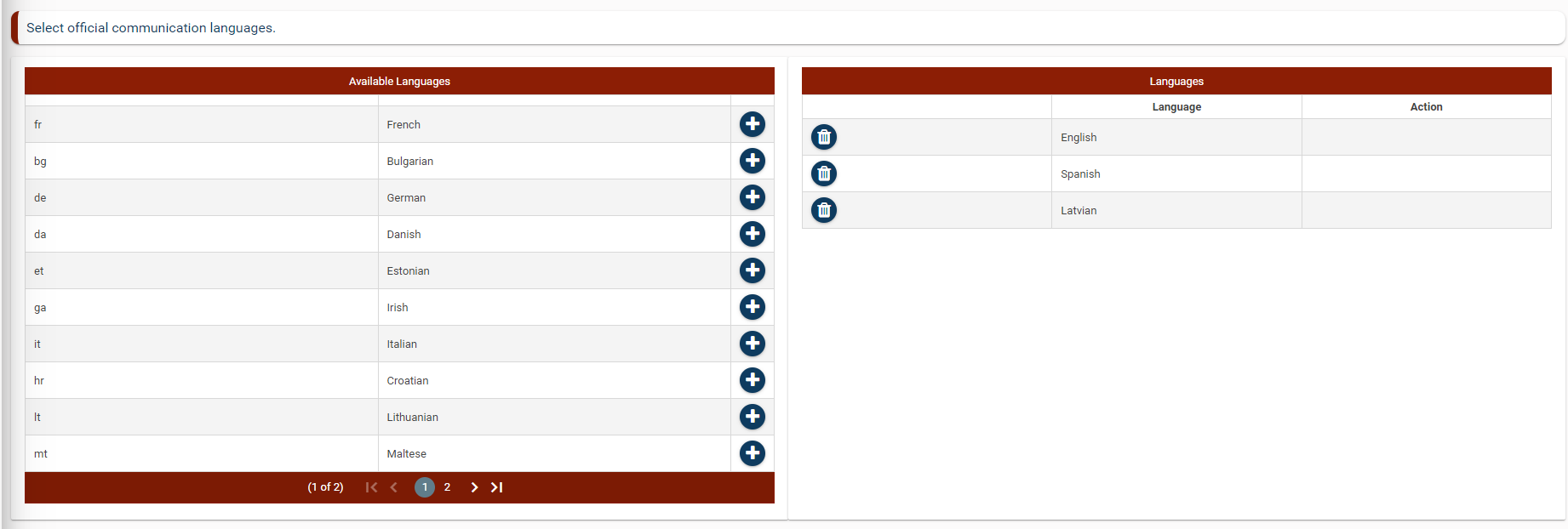
To create a language modification apllication, you must display tthe list of company authorizations through the Licenses option of the main menu. Then, you need to select the authorization in which you are interested and select, in Options, the Languages Modification option.
The application shows the selected languages in the Languages panel.
You may add a new language through the icon in the Available Languages panel,
or remove a service through the icon in the Languages panel.
After filling in the application, you can submit it for processing by EETT.
5.4. Documents update
The application gives the possibility to update the documents of a icense.
This is particularly useful for businesses with General or Individual License for Postal Services in order to inform EETT about the Charter of Obligations to Consumers, Price List etc. You can declare the update of the documents of a licence through the application Documents update.
To create a documents update application, you must display the list of company authorizations through the Licenses option of the main menu. Then, you need to select the authorization in which you are interested and select, in Options, the Documents Update option.
The generated application includes all the valid documents of the license. You can remove the ones that are not valid anymore and upload new documents.
| If any of the license documents does not change, it must remain in the application. You shoulde not delete it. |
After completing the documents upload, you can submit it for processing by EETT. If the application is approved, then the documents of the license will be updated and displayed in the Documents section of the license.
5.5. Cessation of authorization activities
In order to declare the cessation of the activities of a license (i.e. authorization)
you must submit the appropriate application. To create a license cessation application,
you must display the list of licenses through the
Licenses option of the main menu.
Then, you will need to select the license in which you are interested and select,
in Options, the License Cessation option.
You can submit the application for processing by EETT. Upon submission of the application, the license shall be automatically suspended. Cessation becomes definitive upon approval of the application, whereupon the authorization becomes inactive. In case the license is subject to annual fees, a fee notification should be submitted for the period during which it was in force. Upon submission of the application for the license cessation, an annual fee notification is automatically created in order to be completed and submitted. Following the final approval of the annual fee notification, the activities are ceased permanently in the EETT registry.
5.6. Activation of authorization
A license (i.e. authorization) can be activated in case of
prior cessation of activities.
To create a license activation application, you must display the list
of company authorizations through the Licenses option of the main menu.
Then, you need to select the license in which you are interested and select,
in Options, the License Activation option.
After creating the application, you can submit it for processing by EETT. Upon final approval of the application, the license becomes active.
6. Number management
The eregistry application enables the management of NNP numbers. Through the application, the National Numbering Plan is conveyed and numbers are assigned to companies.
| To access the number management operations, you must first obtain the numbering right authorization. |
6.1. National Numbering Plan
Numbers are assigned in blocks. The eregistry application captures the NNP in the block format
<SERIES><BLOCK>
The series and the blocks of numbers are created in advance.
The series created are accessible through the Numbering/Series option of the main menu.
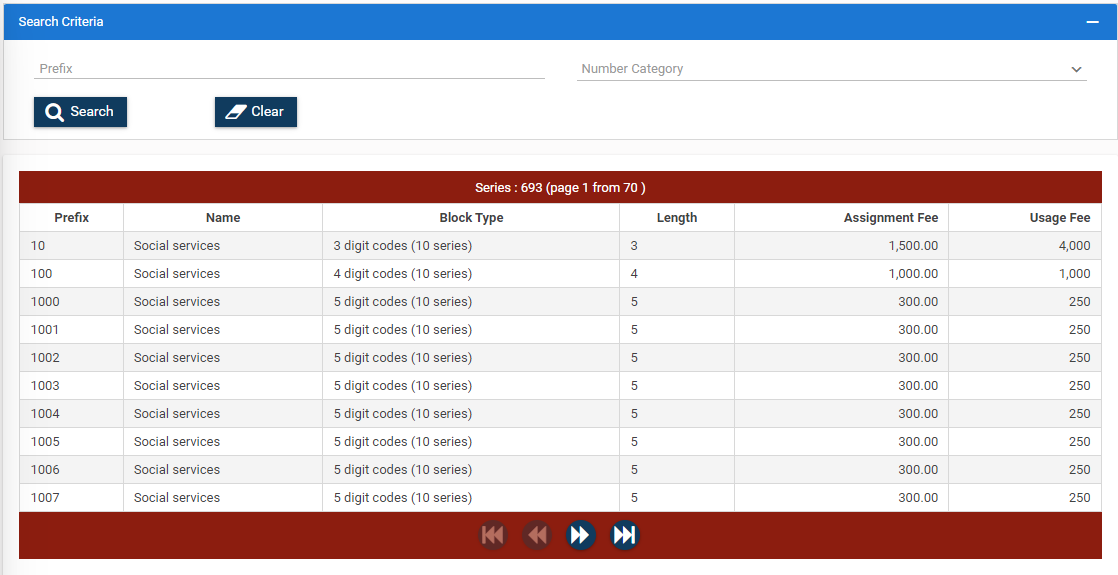
The main menu Numbering/Blocks option provides access to the NNP number blocks.
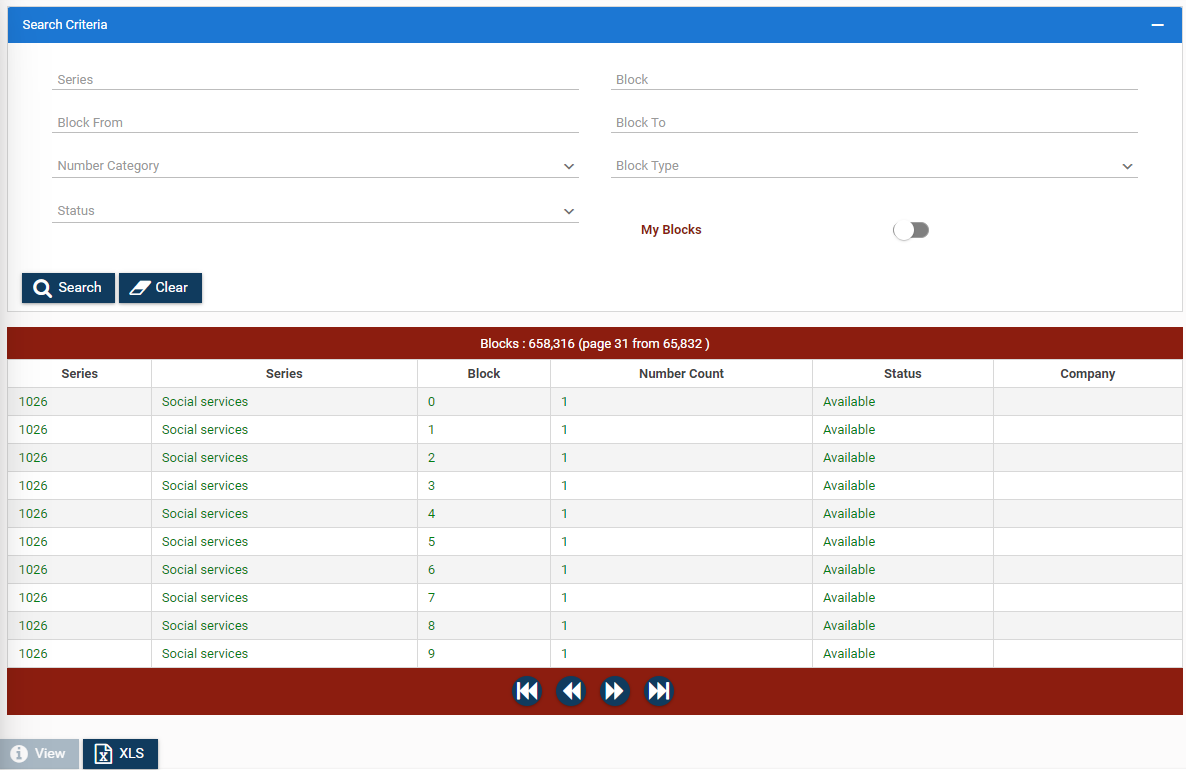
All created blocks are displayed with an indication of their status. The different block statuses are shown in the table below.
| Status | Notes |
|---|---|
Not available |
The block is not available for assignment. |
Available |
The block is available for assignment. |
Locked |
The block is not available for assignment due to overlapping with another assigned block. |
Assigned |
The block has been assigned to a company. |
Reserved |
The block was assigned, has been revoked but is reserved for a period of six months following the revocation. |
The number blocks page provides search criteria to limit search results.
It also provides access to detailed block items,
including block history, through the View option.
The block view page displays the current information concerning the block,
offering the additional option of viewing the block history.
A table of your company’s approved applications regarding the block is also displayed.
6.2. Number assignment
To assign numbers, you must complete and submit a
number assignment application through
the New Application/Numbering/Number Assignment option of the main menu.
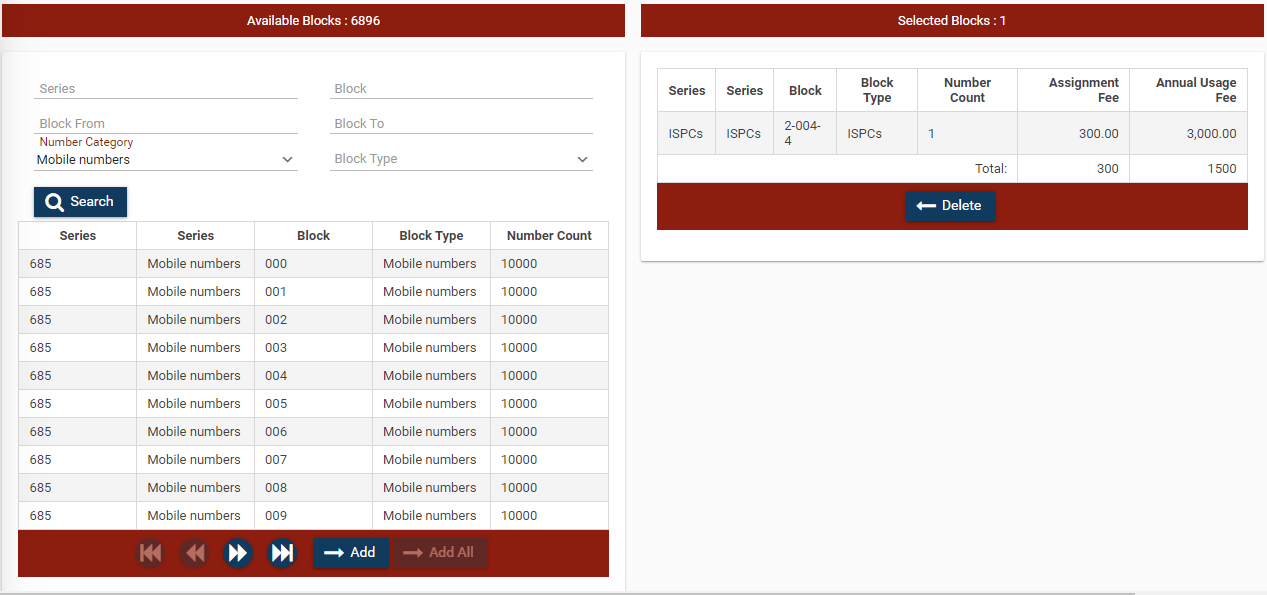
The number assignment application shows the available NNP blocks (Available Blocks table).
The table also includes the blocks retained by your company,
in case you wish to assign blocks that you have previously revoked.
Search criteria are provided for you to find the block you want.
Blocks may be selected individually or through multiple selection.
You may select an individual block from the Add option.
For the multiple block selection, you must specify in
the search criteria the Series of blocks you want and then you must specify,
through the Block From and Block To options, the range of blocks you want.
Select Search to view the blocks in the specified range,
and then Add All to add the blocks to the list of blocks to be assigned.
| To add multiple blocks, the Series must first be selected in the search criteria of the list of available blocks. Otherwise, multiple blocks cannot be added. |
The Selected Blocks panel shall display the number blocks requested for assignment.
A block can be removed from the request through the Delete option.
The table displays for each block the annual assignment and usage fee.
The eregistry application allows, prior to the final submission of the application, for the payment of the fees for the assignment and use of numbers. If no fees are paid at the time the application is submitted, the application shall be returned by EETT so that fee payment can be performed following the preliminary processing of the application. Fees can be paid at a later stage through the processing of companies tasks.
6.3. Secondary assignment
The application for secondary assignment shall be submitted in cases where short codes,
which are primarily assigned to a provider, are assigned for use to another party
(secondary assignment). The application shall be submitted by the
provider to whom the number is primarily assigned.
You can submit a secondary assignment application
by selecting New Application/Numbering/Secondary Assignment.
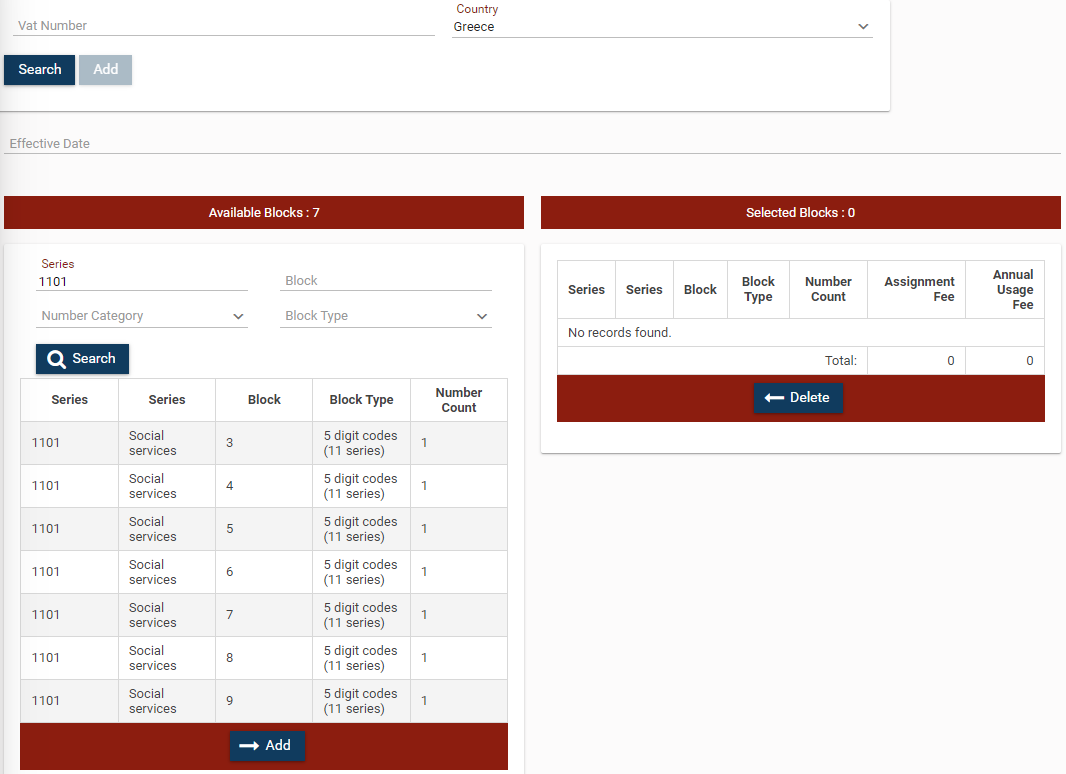
Before selecting the secondary assignment blocks,
the company/party using the numbers should be defined.
To define a company, you must search it in the eregistry application.
The vat number is indicated in the Vat Number field,
and the Search button is used to search for the company in the registry.
If the company exists in the registry, its details are displayed.
If the company has no users,
you will also be able to modify the basic company details.
If the company can not be found, you must enter its basic details therein.
Following the definition of the company/party to which the
secondary assignment is to be granted,
the number blocks should be selected. The secondary assignment application
displays the available NNP blocks for which the secondary assignment is available
(Available Blocks table). The table also includes the blocks retained by your company,
in case you wish to assign blocks that you have previously revoked.
Search criteria are provided for you to find the block you want.
Blocks may be selected individually or through multiple selection.
You can select an individual block from the Add option.
For the multiple block selection, you must specify in the search criteria
the Series of blocks you want and then you must specify,
through the Block From and Block To options, the range of blocks you want.
Select Search to view the blocks in the specified range, and then Add all
to add the blocks to the list of blocks to be assigned.
| To add multiple blocks, the Series must first be selected in the search criteria of the list of available blocks. Otherwise, multiple blocks cannot be added. |
The Selected Blocks panel shall display the number
blocks requested for assignment. A block can be removed from the
request through the Delete option. The table displays for
each block the annual assignment and usage fee.
The eregistry application allows, prior to the final submission of the application, for the payment of the fees for the assignment and use of the numbers. If no fees are paid at the time when the application is submitted, the application shall be returned by EETT so that fees are paid following the preliminary processing of the application. Fees could be paid at a later stage through the completion of tasks.
In the case of numbers for which a description of use is required,
the Block Usage field should also be filled in.
In those cases it is suggested that the submission of
the application pertains to one block only.
|
6.4. Number revocation
To revoke assigned blocks, you must complete and submit a number
revocation application through the New Application/Numbering/Number Revocation option
of the main menu.
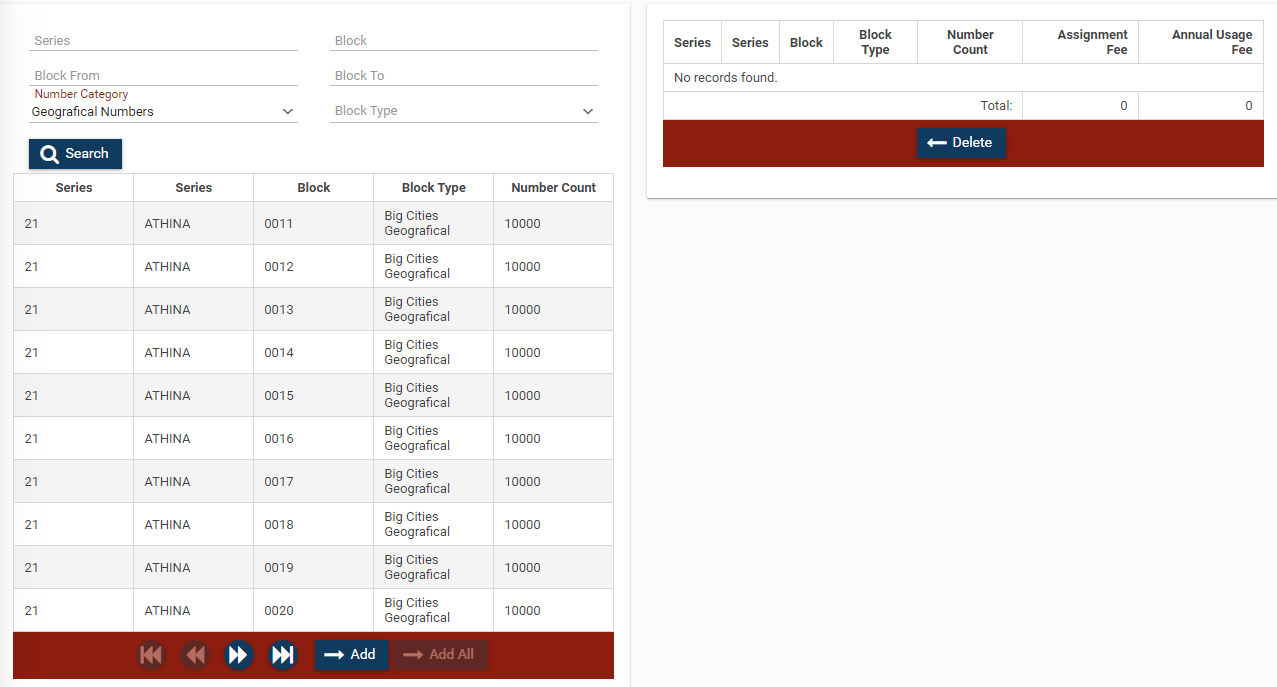
The Available Blocks panel displays all blocks which have been assigned to your company.
The Selected Blocks panel displays all blocks which have been selected for revocation.
Through the Add option, an assigned block is added to the blocks selected
for revocation. Through the Delete option, the block to be revoked
is removed from the panel of selected items.
After selecting the blocks for revocation, you
can submit the application.
The revocation of numbers results in the reservation of blocks for a period of six months following the approval of the application. Within this period, the numbers are reserved and cannot be assigned. Only your company can apply for the revoked blocks to be assigned. The blocks included in number portability are excluded from being reserved. In these cases, the blocks are automatically transferred to the company with the most numbers ported within a given block.
| The above retaining of blocks for a six-month period does not apply to the following: (a) short codes of series 116, the use of which is determined by European Commission Decisions about harmonized use throughout Europe; (b) five-digit short codes of series 14, 190-196, 54, 198; and (c) groups of numbers of series 901, 909, 806, 812, 825, 850 and 875. |
6.5. Secondary assignment transfer
A secondary assignment transfer is the process where the company to which a number block has been assigned on a primary level under secondary assignment, applies for the secondary assignment to another company/party. The same application can be used in cases where the block has not been assigned on a secondary level to your company, but only on a primary one.
The application shall be the same as the one for the secondary assignment of numbers without fees.
6.6. Secondary assignment removal
Secondary assignment removal is the process where the undertaking to which a block of numbers has been assigned on a primary level under secondary assignment, applies for the removal of the secondary assignment. Upon approval of a secondary assignment application, block management shall be transferred to the company to which it has been assigned under primary assignment.
6.7. Primary assignment transfer
The transfer of the primary assignment of blocks pertains to cases
where the holder of the secondary assignment wishes to change provider for
the numbers he/she holds. You may submit a primary assignment transfer
application by selecting New Application/Numbering/Primary Assignment Transfer.

To be able to submit the application, you must select
the blocks from the Available Blocks panel. After finding
the block and selecting Add, the block is moved to the Selected Blocks panel.
The primary assignment application shall be subject to assignment fees.
The application allows, prior to the final submission of the application, for the payment of fees for the number assignment. If no fees are paid at the time when the application is submitted, the application is returned by EETT so that fees are paid following the preliminary processing of the application. Fees can be paid at a later stage through the completion of tasks.
6.8. Modification of use of numbers
The application to modify the use of numbers changes the use of numbers in cases where a description of use is required.
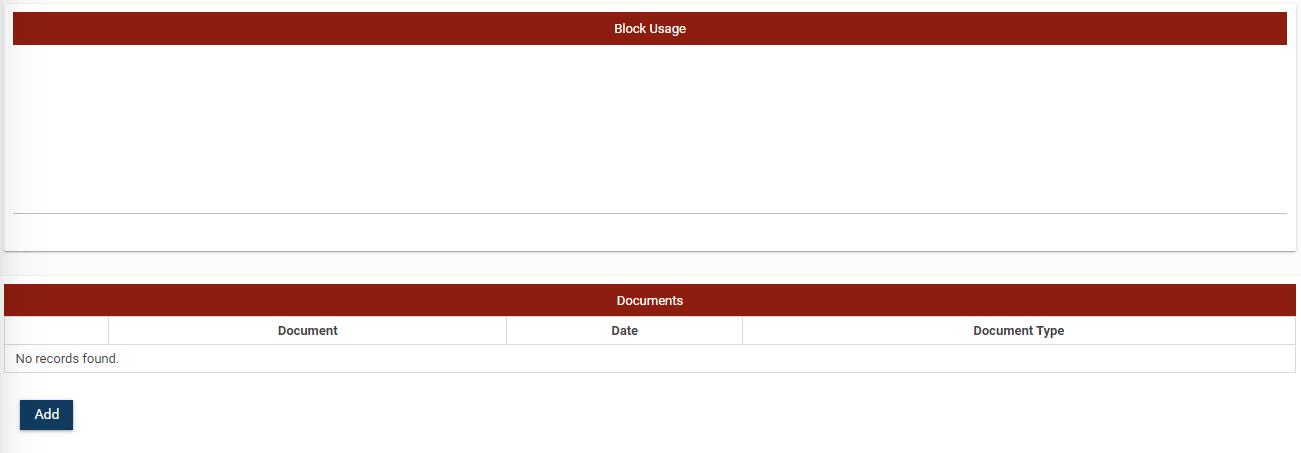
To be able to submit the application, you must select the blocks
from the Available Blocks panel. After finding the block and selecting Add,
the block is moved to the Selected Blocks panel.
Then, you will need to fill in the Block Usage field.
| The description of the use of numbers is related to all selected blocks. In case you want to enter a description for a single block, it is recommended to submit a request only for that specific block. |
7. Management of postal networks
Postal networks are companies that cooperate with a licensed postal services provider in order to provide services on its behalf. Postal networks include cooperating companies and specific customer service points. The eregistry application enables the management of the postal network of a registered company, preserving the data history.
The management of postal networks is an independent but complementary function of the authorization process. Applications relating to networks are separated from authorization requests. However, the network is considered active only if your company operates under general authorization or holds an individual license for postal services.
7.1. Network members
By selecting the option Profile/Postal Network Members from the main menu,
the table with the members of your company’s postal network is displayed.
Postal network members include:
-
single branches of your company,
-
cooperating companies that operate under general authorization or hold an individual license for postal services,
-
other cooperating companies.
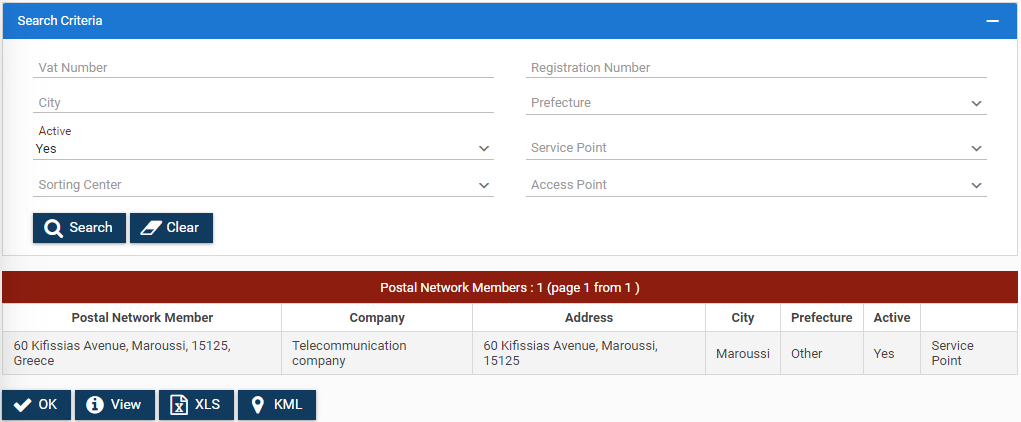
Search criteria are provided to enable the search for postal network members, namely:
-
The member’s company vat number. If the vat number is the same as the vat number of your company, the table shall display the branches of your company.
-
The EETT Registration Number. This concerns companies that have been authorized by EETT.
-
City. The city where the member’s point of service is located. You can enter only the first letters of the name of the city you are interested in.
-
Description. The member description.
-
Perfecture. The Prefecture of the member’s point of service. You can select from the drop-down list.
-
Active. The table shall display both active and inactive network members. If you select
Yesin the active field, only the active members of the network will be displayed. -
The fields that are specific to each network member. By selecting
Yes, you limit the results of the table to members with specific characteristics.
Through the View option, you are transferred to the view page of the network member,
where you are able to view the data history.
By clicking the XLS button you can export the data of the members to an
Excel file.
| The geographic coordinates of the members of the postal networks are usually derived from automatic geolocation based on the postal address. If the geographic coordinates are not known, the points appear in the area of Syntagma Square in the center of Athens (37.974541, 23.734390). The coordinates are corrected by submitting a request for the modification of the postal network, which allows for manual entry of the coordinates. |
In order to modify the composition of the postal network, you must submit an application for its modification.
7.2. Postal network modification
By selecting the option New Application/Postal Network Modification
from the main menu, you can create a new application to modify the postal network.
By this application you may:
-
Add a new member to the postal network.
-
Remove an existing member from the network.
-
Update the details of an existing member in the network.
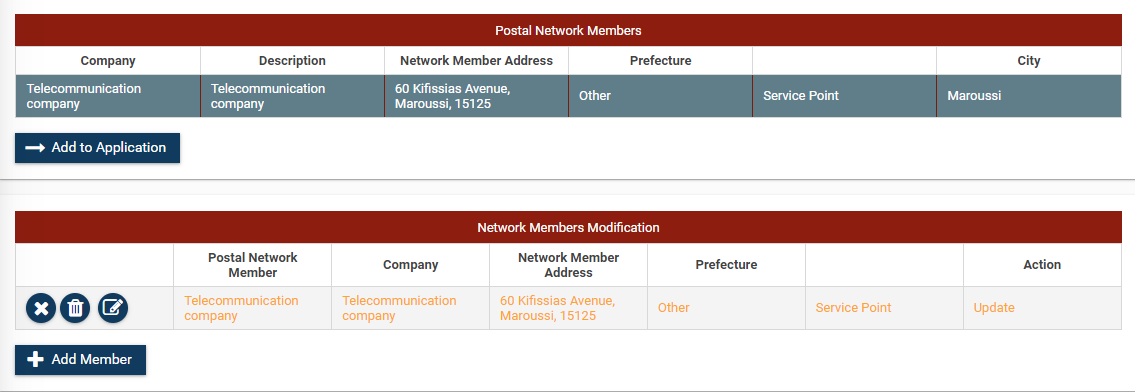
The Network Members Modification panel includes all network members
that are referred to in the application. Through the Add Member button,
a new member is created in the network.
You can update the member details.
The Postal Network Members panel includes all existing members of the postal network.
Through the Add to Application option, you may transfer an existing member
to the application. There are two options for the existing member.
The first option is to update the network members’ details via the icon.
The member registration page
is displayed.
The second option is to remove the member from the network via the icon.
With the icon the member is removed from the application.
Upon completion of all changes to the postal network, you can submit the application.
7.2.1. Edit a network member
The edit process of a postal network member consists of four sections:
-
the company participating in the network. In the case of a single branch, the company participating in the network is the company owning the application;
-
the postal address of the company’s registered offices. In the case of a single branch, the postal address of the registered offices equals that of the company that submitted the application;
-
the postal address of the point of service. The postal address may be the same as that of the registered offices of the company or it may differ;
-
the properties of the network member. A description is required, indicating the name of the network member, the prefecture where it operates and its designation as a service point, sorting center or access point.
The four sections appear as different tabs on the member’s page.
The Next and Previous options are available for navigating the tabs.
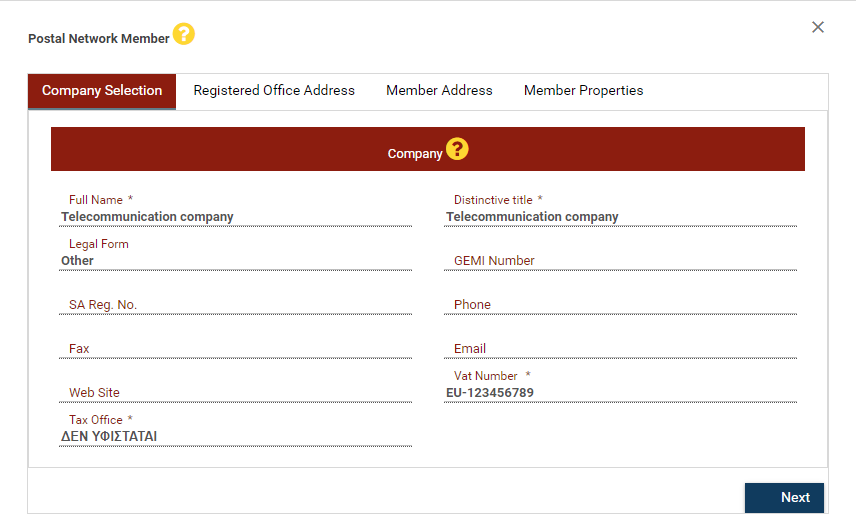
In the Company Selection tab, the basic details of the member company are
requested. In the case of a new member,
the company submitting the application is selected by default.
It is possible to change the company by searching using a vat number.
In case you want to change the company, enter the vat number and select Search.
If the company already exists in the registry, its details will be displayed.
Depending on whether the company is in the registry or not,
you can modify its details.
If it is not registered, you can enter its details through the Add option.
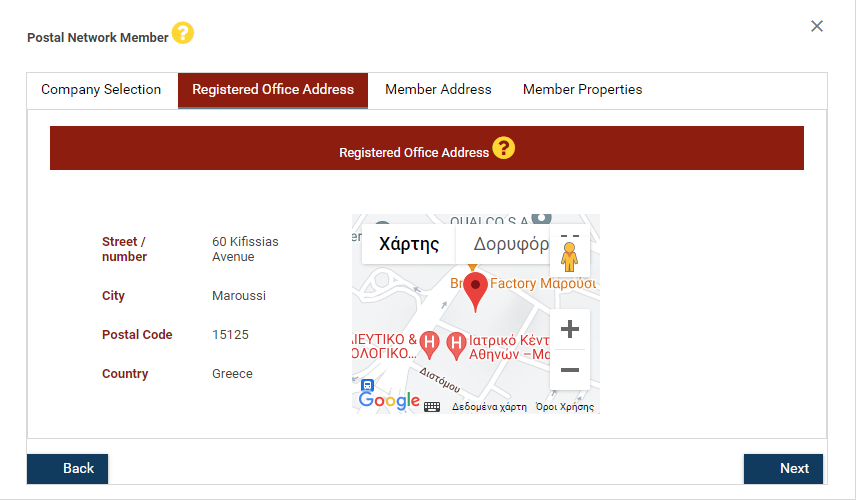
In the Registered Office Address tab you can enter the registered
address of the company. The possibility to update the
address is provided only for companies that are not registered in the registry.
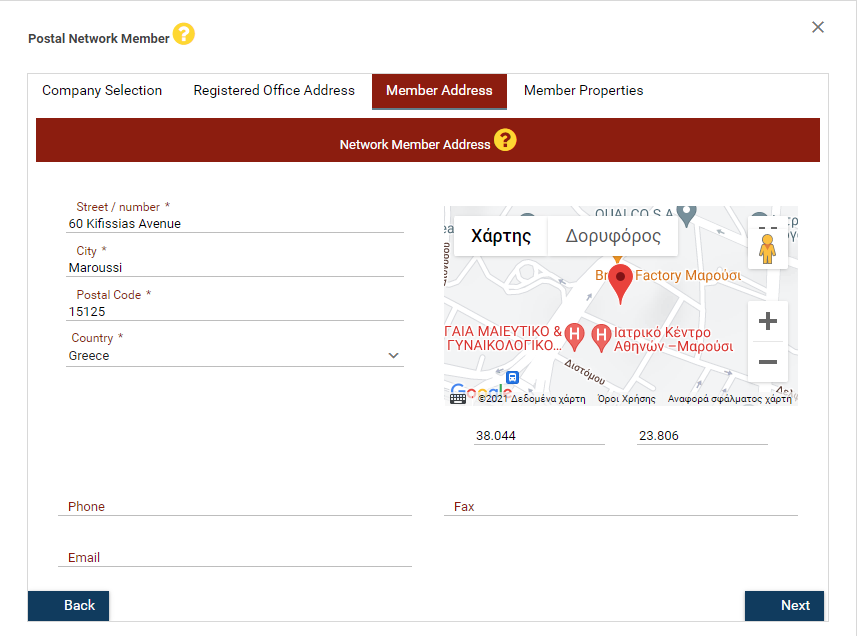
In the Member Address tab, you can enter the address
of the network member’s service point.
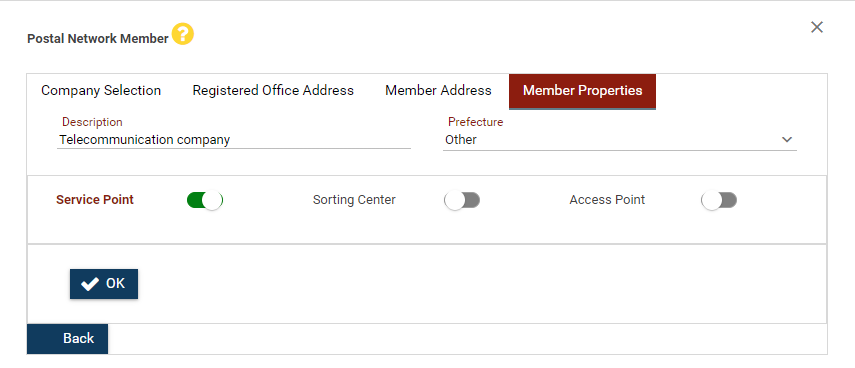
In the Member Properties tab, a description of the network member is provided,
the prefecture in which it provides services is specified and the information whether
it is a service point and/or a sorting center operating under a general
or with an individual license, is given.
| The indication of the role of the member is independent from the current authorization status of the company. Network members are deemed inactive if the applicant company does not operate under general authorization or doesn’t hold an individual license. In order for the members to be considered active, you must obtain the general authorization or the individual license for postal services. |
8. Annual fees
The eregistry application provides functionality for the submission of notification of annual fees for licenses which are subject to fees, as well as the submission of notification of payment of annual fees for numbers.
8.1. Notification of license fees
For the general authorization for electronic communications, the general authorization for postal services and the individual license for postal services, fees are paid to EETT, based on the annual gross revenue of the respective activity and are calculated in accordance with EETT regulations. The notification of annual fees is generated automatically by the application. The application also calculates automatically the annual fees. The fees must be paid and the fee notification must be submitted within the deadlines set out under EETT regulations.
| The approval by EETT of the fee statement is made with the reservation of EETT that, on the one hand, the declared data are according to the statement of the provider and, that, on the other hand, EETT is not deprived of the right for any further audit. |
8.1.1. Annual general authorization fees for electronic communications
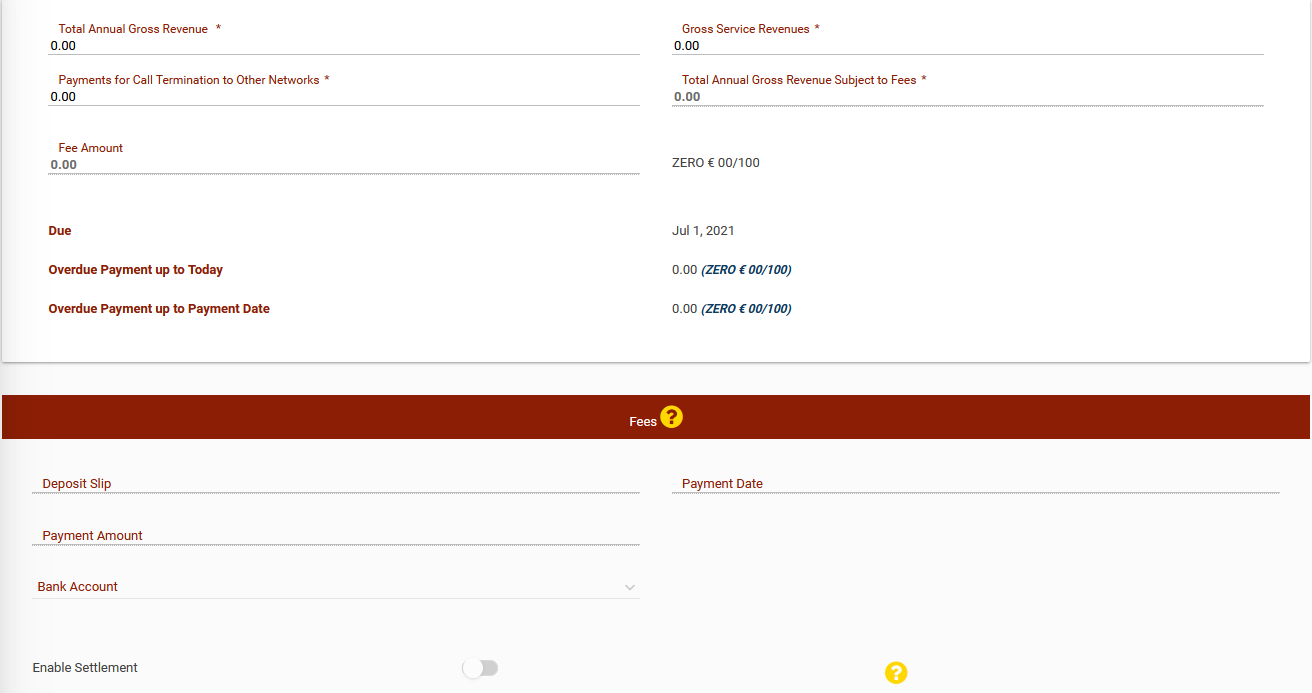
The fee notifications are applications, like the other applications
in the registry and they are accessible from the main menu
through the Applications option. To edit the
fee statement for the general electronic communications authorization,
you must fill in:
-
the total gross revenue;
-
the gross revenue from the provision of electronic communications services;
-
and the call termination costs
The application calculates the revenue which is subject to fees, as well as the amount of the corresponding fee, using as calculation base the revenue which is subject to fees. After paying the fees, you must enter the fee deposit information.
If the fees are paid within the payment deadline,
it shall be possible to activate a settlement.
Through the Enable Settlement option, you can request a fee settlement.
To activate the settlement, at least 30% of the fee must be paid in advance.
The settlement shall be activated once EETT has approved the corresponding statement.
The settlements are monitored by eregistry,
via the Installment Payment application.
| The option to settle fees is activated only if the date of payment of the fee is filled in. |
In case of payment of the fee after the payment deadline,
the default interest is also calculated. The Overdue Payment up to Today
field displays the amount of the fee including interest
calculated up to the current date. The Overdue Payment up to Payment Date
field shows the amount of the fee including interest
calculated up to the payment date, which is the deposit filing date.
|
8.1.2. Annual fees for general authorizations for postal services
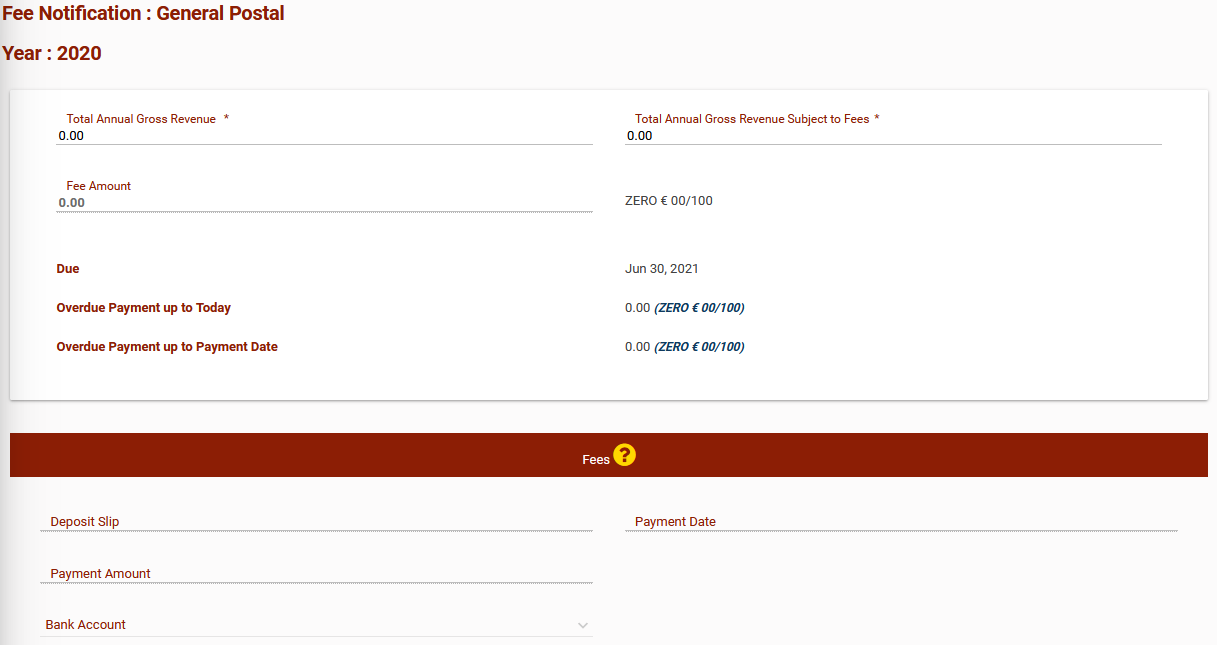
The fee notifications are applications as all others in the registry
and are accessible through the Applications option in the main menu.
To complete the application, you need to fill in the total gross revenue, the gross revenue subject to fees of the reference year and the number of tracks, only in the case that the gross revenue subject to fees is less than 100,000.00 euros.
The amount of the fee is calculated by the application, after the calculation base is defined according to the amounts that are declared.
You must also enter the fee deposit information.
| The number of trucks is necessary only for the years from 2024 onwards. For previous years, such information is not required and there is no change in the method of calculating fees, regardless of the gross revenue subject to fees. |
In case of payment of the fee after the payment deadline,
the default interest is also calculated. The Overdue Payment to Date
field displays the amount of the fee including interest
calculated up to the current date. The Overdue Payment until Payment Date
field shows the amount of the fee including interest
calculated up to the payment date, which is the deposit filing date.
|
8.1.3. Annual fees for individual licenses for postal services
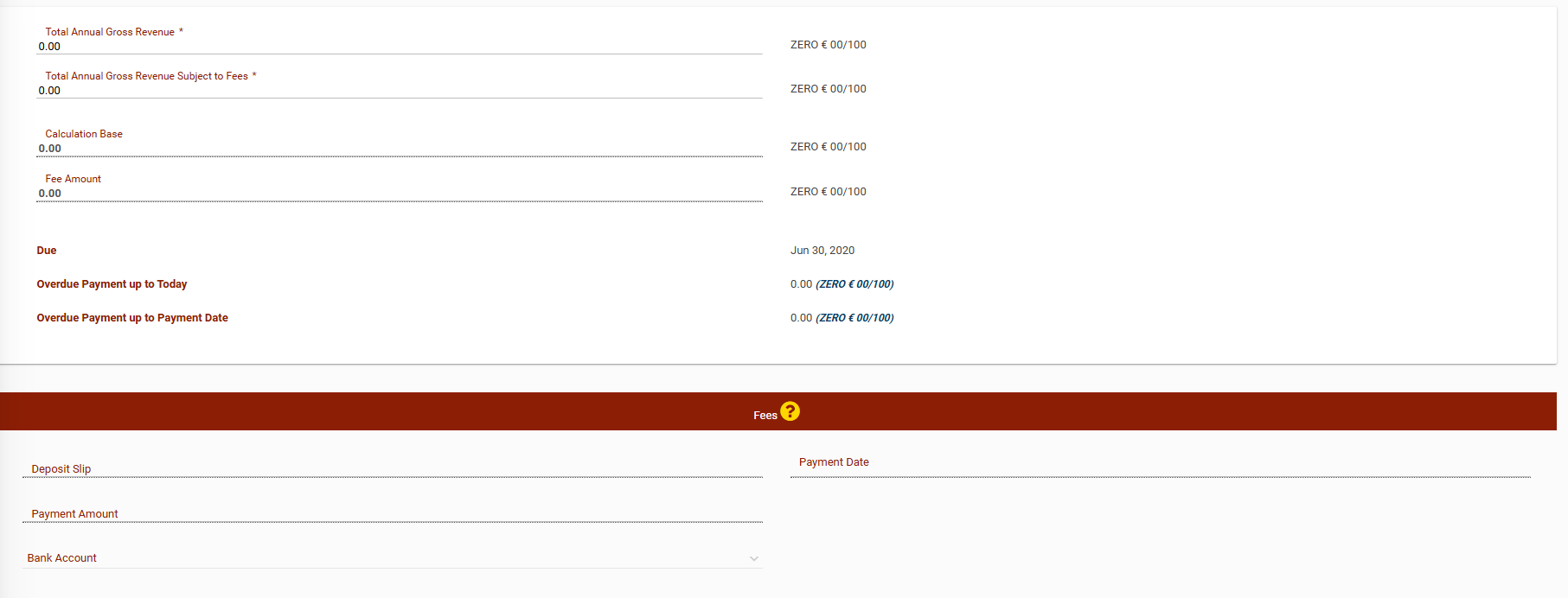
The fee notifications are applications as all others in the registry
and are accessible through the Applications option in the main menu.
To complete the application, you need to fill in the total gross revenue
and the gross revenue subject to fees of the reference year.
The amount of the fee is calculated by the application, using as calculation base the gross revenue which is subject to fees.
You must also enter the fee deposit information.
In case of payment of the fee after the payment deadline,
the default interest is also calculated. The Overdue Payment to Date
field displays the amount of the fee including interest
calculated up to the current date. The Overdue Payment until Payment Date
field shows the amount of the fee including interest
calculated up to the payment date, which is the deposit filing date.
|
8.2. Numbering annual fee calculation
The eregistry enables the calculation of the annual fees
for numbers through the Numbering/Annual Fee Calculation option of the
main menu.

The annual fees are calculated for the current year on
the basis of the numbers assigned at the end of the previous
year and in accordance with the procedures of EETT’s regulation on fees.
The Calculation button provides a summary report of
the corresponding fees which can then be exported to an Excel file through the XLS button.
The Details button generates an Excel file with details per assigned block of numbers,
which corresponds to the aggregated calculation of fees.
The file generated through the Details button refers to
the assigned blocks included in the calculation of fees,
and not the current status of the assigned blocks.
|
The file generated by the Details button may contain multiple
lines depending on the assigned blocks. You can use the Excel
pivot table to group the detailed entries and compare them with
the summary fee calculation report.
|
8.3. Annual number fees notification
The eregistry calculates the annual fees for the use of numbers,
in accordance with the relevant EETT Regulation. The notifications on
the payment of fees for numbers are applications,
like the other applications in the registry, and they are
accessible from the applications panel through the Applications
option in the main menu.
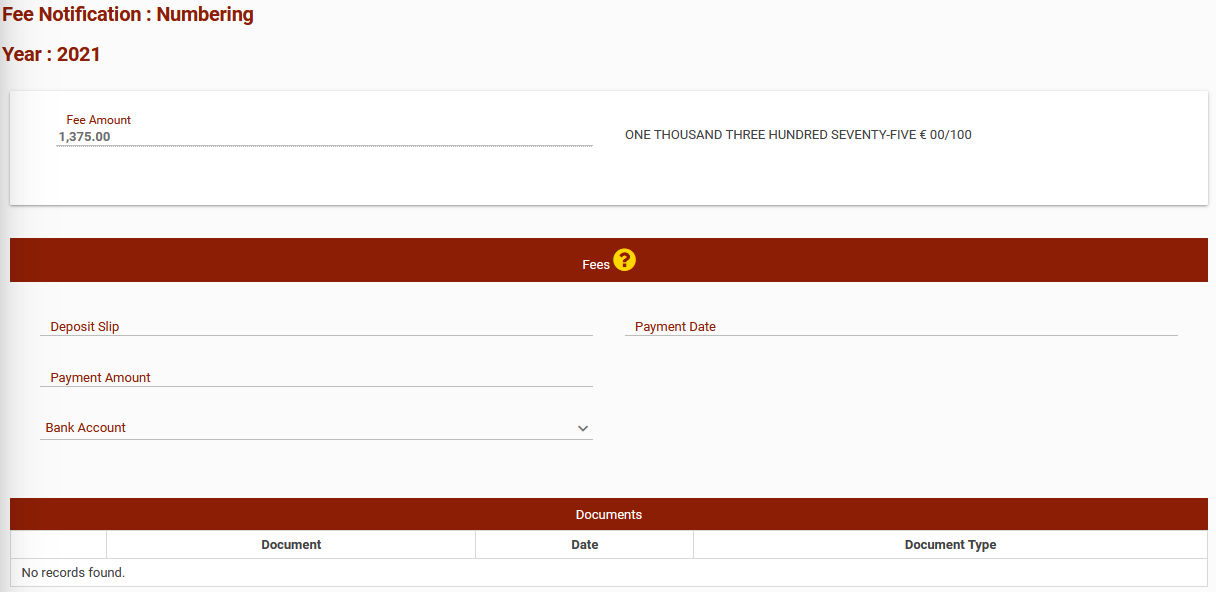
The fees have already been calculated and you only need to enter the information on the payment of the fees.
If the fees are paid within the payment deadline,
it shall be possible to activate a settlement.
Through the Enable Settlement option, you can request a fee settlement.
To activate the settlement, at least 30% of the fee must be paid in advance.
The settlement shall be activated once EETT has approved the corresponding statement.
The settlements are monitored by eregistry,
via the Installment Payment application.
| The option to settle fees is activated only if the date of payment of the fee is filled in. |
8.4. Fee Settlements
Particularly for the general electronic communications authorizations, it is possible to pay the annual fees through settlements. To activate a settlement for general authorization fees, the timely (by the 1st of July of each year) payment of at least 30% of the calculated fee is required. In this case, the application gives you the option to activate the settlement. The process of activating and completing a settlement is shown in the figure below.
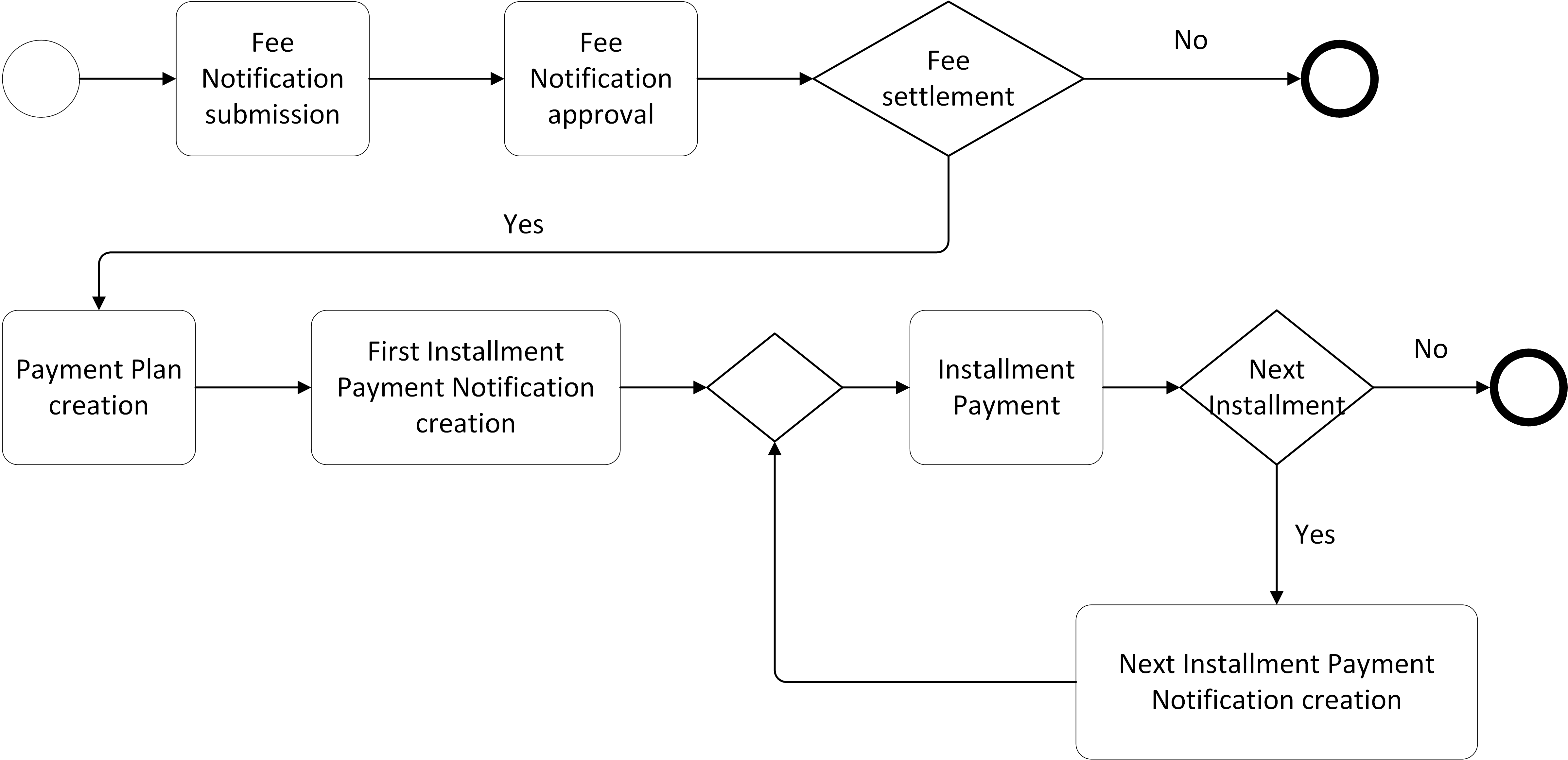
In the first step, it is necessary to request the activation of the settlement, when submitting the fee statement. Once the fee statement is approved, the six-month payment plan for the remaining amount of the fee is created

The Payment Plan table includes the following information:
-
The installment
Number(from one to six). -
Installment Amount. The initial amount of the installment, except for the interest for the payment of the fee. -
Due. The payment due, to ensure that the payment plan is adhered to. -
Unpaid Fee. The outstanding amount, including interest, prior to taking into account the payment of the installment. -
Paid Amount. The amount paid as an installment. -
Payment Date. The date of payment of the installment. -
Interest Days. The days for which the interest is calculated, based on the date of payment of the installment and the date of payment of the previous installment. -
Interest. The interest calculated for the interest days and the Bank of Greece interest rate. -
Remaining Fee. The remaining amount, including interest, calculated following the payment of the installment. The remaining amount becomes theUnpaid Amountof the next installment. -
Payment confirmation. It is completed by EETT after the confirmation of the payment of the installment.
| The table is updated each time upon final approval by EETT of the installment payment notification. |
Upon generation of the payment plan, the first installment payment statement is also created. Upon payment of each installment and following approval thereof by EETT, the next statement is automatically generated, until the payment plan is exhausted or the fee is paid in total.
| The settlement payments plan, the payments and the interest are shown in the fee notification application. |
8.5. Installment Payment Notification
The Installment Payment application is automatically generated
by the eregistry application during a fee payment settlement.
It automatically receives a reference number
and is available in your company’s unassigned tasks.
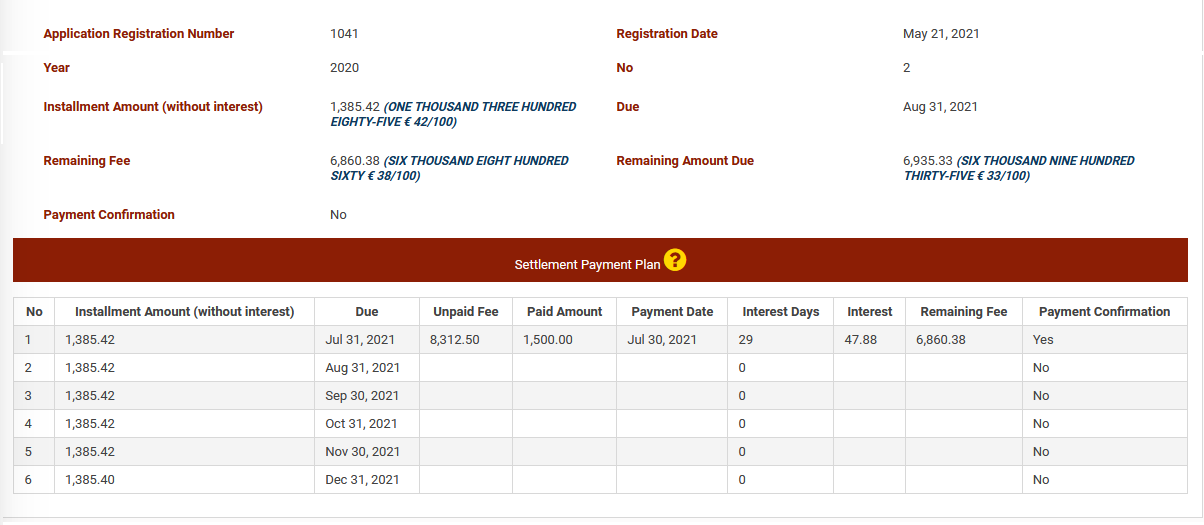
In addition to the main elements of the application (reference number and date), the number of the installment, the initial amount of the installment and the remaining amount of the fee are displayed on the payment statement view page. The payment plan and the way in which the plan is carried out over time are also displayed.
The statement shall be filled in through the statement processing page as shown in the figure below.

The page for processing the notification displays the main information of the notification. You are asked to fill in the details of the paid fee and to forward the notification to EETT through the eregistry. The amount of the full payment of the fee is also displayed on the processing page.
The steps for completing the installment payment and forwarding it to EETT are as follows:
-
The notification shall appear in the
Unassigned Taksof your company. The statement must be assigned to an end user of your company. Only after being assigned it may be completed. -
After the statement is assigned, it shall be available on the operator’s
Pending Tasks. The end user selectsProcesson the pending task page to display it. -
The end user selects
Applicationon the pending task page to display the notification view page. -
The end user selects
Editto display the notification edit page. The end user fills in the deposit slip number, the deposited amount, the date of the deposit and the bank account to which the deposit was made. -
The end user selects
Saveand the statement view page is displayed. -
The end user selects
OKto return to the pending task page. -
The end user selects
Options/Forward to EETTon the pending tasks page, to forward the statement to EETT.
| It is not enough to complete the fee statement. The final, necessary, step of the above process is to forward it to EETT. |
9. User management
The eregistry application enables each registered company to manage its users.
Users are managed only by the Admin User role.
By selecting Profile/Users in the main options menu, the list of
company users is displayed.
From the list page, it shall be possible to edit
a user’s data or to create a new user.

| Only the Admin User can manage the users of the company. |
The main information of each user is the e-mail address used to login to the eregistry application. The password of each new user is sent to that e-mail address.
The options for managing a user are the following:
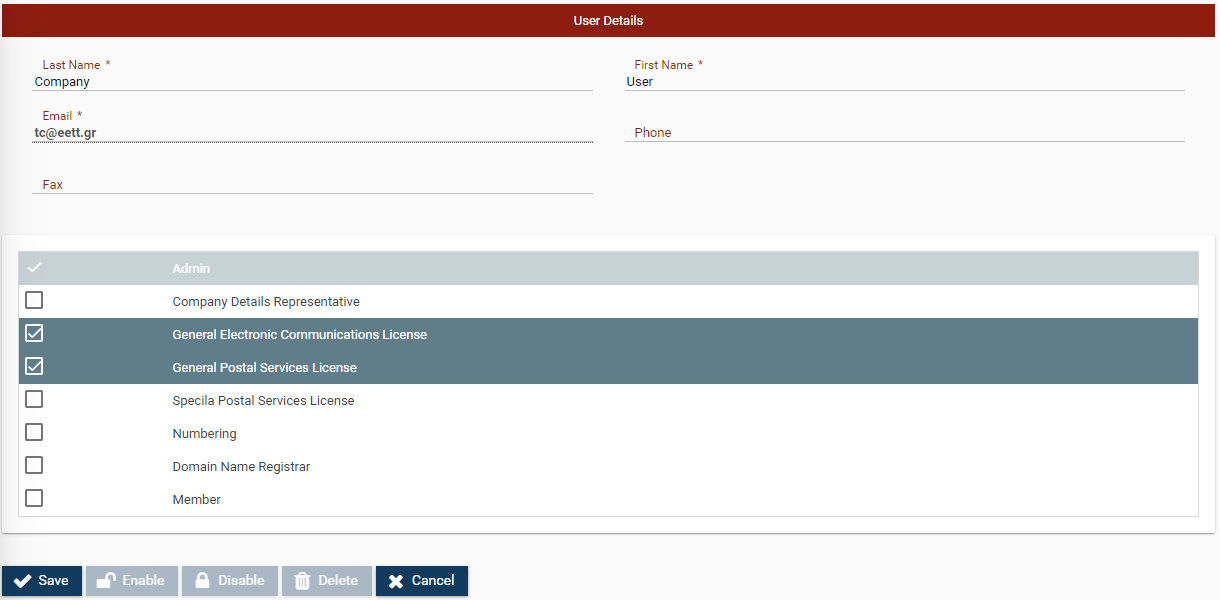
-
User data modification. If the user has been activated in the past, it is not be possible to update the e-mail address.
-
User activation. When the user is being activated, the eregistry automatically sends the user’s password to the e-mail address.
-
User deactivation. Upon deactivation, the user will no longer be able to login to the eregistry web application.
-
User deletion. User deletion is only allowed for users that have not been activated. If the user has been activated in the past, it is only possible to deactivate (but not delete) the user.
-
Assigning or removing roles. The appropriate options are used to assign roles to the users or deprive them from such roles. The only role that cannot be assigned or removed is that of the Admin User.
10. Common tasks
10.1. Company profile
By selecting Profile/Company, you have access to the details
of your company as those were entered in the registry.
The main details of the company, the registered offices,
the representatives and the legal documents are provided.
It is also possible to navigate the history of the company.
To change the details of the company or to update the required documents, you must submit an application for the modification of company details.
10.2. Attaching a document
To attach a document, it is necessary to enter the necessary document information before uploading the file.
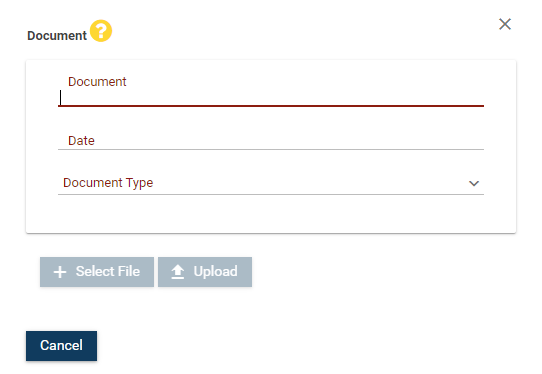
The necessary document identification information is the following:
-
Document: The reference number (e.g. protocol number, Government Gazette, number) or any other document identifier.
-
Date: The date of the document.
-
Document Type: Select from the list of document types.
Once the document details are completed, the Select File option shall be activated.
The file may be selected from the local computer and then it is
transferred to the application though the Upload option.
The file is not saved automatically after being attached.
Select Save or OK on the main page of the application to save the document.
|
10.3. Edit company information
At several points in the eregistry, it is required to enter the details of a company. The main details of a company are its name, its distinctive title, its legal form and the competent Tax Office, in case the company has its registered offices in Greece.

| If the company has no distinctive title, enter its name. |
Moreover, it is mandatory to enter the address of the company’s registered offices. For registered companies, it is possible to enter the billing address separately. This is the address to which the invoices issued by EETT for the payment of fees are sent.
| The billing address, if it is completed, is printed on the invoices issued by EETT. Otherwise the address of the registered offices is used. |
10.4. Edit fee details
In the context of submitting applications or fee notifications, information related to the payment of the fees is requested. Fees are always paid through deposits to EETT bank accounts, prior to the update of the eregistry data. Fee details must be entered so that the deposits can be identified.

The required data are the following:
-
The deposit slip number identifying the deposit.
-
The amount of the deposit.
-
The date of the deposit.
-
The EETT bank account.
The fee data registration information should always be accompanied by a digital copy of the deposit slip. The copy of the deposit slip shall be attached to each request through the document attachment operation.
| In some cases the calculated fee amount is zero. In that event, the application shall not require the entry of fee details. |
10.5. Edit representative
In the context of the registration of a company or of the authorization details, it is required to register the details of persons who act as company or authorization representatives.
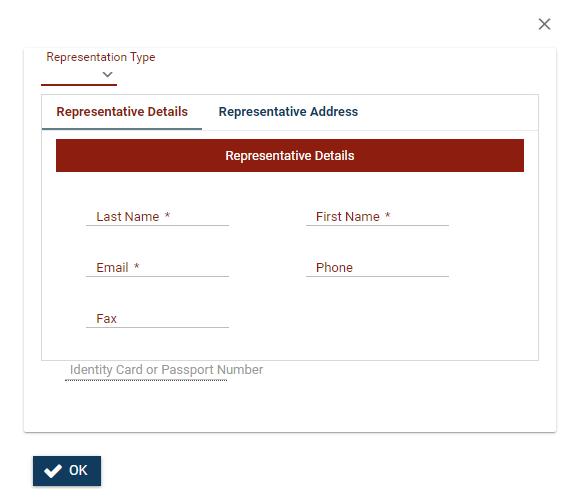
The information requested is contact details and postal address. Particularly in the case of general electronic communications authorizations, it is also possible to add a branch within the EU.
10.6. Edit Address
In several parts of the application, it is required to enter addresses. The full details of each address are requested, namely: street and number, city, postal code and country.

Each address is accompanied by a geographic display on a digital map. Once the full address details are entered, the point is automatically identified (approximately) on the map. The application allows to move the mark on the map to identify the point more accurately. In addition, the application allows to enter the geographic coordinates directly to the WGS84 coordinate system.
10.7. View historical data
The application keeps a history of certain significant information of the register. This information is the following:
-
Companies.
-
Authorizations and the corresponding services.
-
Members of postal networks.
-
Number blocks.
In the view pages of this information, it is possible to view previous versions as indicated in the figure below.

The different versions of the information are numbered and they appear on
the time axis in ascending order, starting with the first version and ending
with the current one. Each different version in time coincides with
an event of modification of the information as a result of the approval of
an eregistry application. Upon selection of the number on the timeline,
the information of the selected version is displayed.
By selecting the Revert button, the current
and last version of the information is restored.
11. Public API
The eregistry application provides information of the corresponding registries as publicly open data via a REST API. The API is accompanied by the OpenApi3 specification and is available to anyone interested in accessing public records of the register. The API detailed documentation is available at https://eregistry.eett.gr/api/openapi.json. This section is addressed to those who wish to use the API and describes the basic principles of data availability.
11.1. Versions
The API version is part of the URL. The current version is v1.
11.2. Resources
The main API resources are the following:
-
Companies. Only information about companies with a known ID (/api/v1/companies) can be retrieved.
-
Authorizations. Information on register authorizations of the registry (/api/v1/licenses).
-
Members of postal networks. Companies and service points for the provisions of postal services (/api/v1/networkMembers).
-
Number blocks. Information on the assigned NNP number blocks (/api/v1/blocks).
The format for representing resources is JSON.
11.3. Resource links
In several cases, the representations of
resources also include hyperlinks via the links option.
11.4. Information lists
Access to information lists is paginated in a typical manner. The API displays the paging information as HTTP Headers, as follows:
| Header | Description |
|---|---|
|
The total number of entries in the list. |
|
The current page of the lists. |
|
The number of pages. |
For non paginated lists
the API shows only the X-Result-Count header.
|
In addition, the API provides as Link headers
the common navigation actions as follows:
rel attribute of Link header |
Description |
|---|---|
|
Access to the first page of the list without search criteria. |
|
The final page of the list, retaining the search criteria, if any. |
|
The first page of the list, retaining the search criteria, if any. |
|
The previous page of the list, retaining the search criteria, if any. |
|
The next page of the list, retaining the search criteria, if any. |
A specific page in a directory shall be accessed through the page parameter,
considering that the number of the first page is one (1).
11.5. Language
The API default language is Greek.
The English language is also supported for part of the content
(e.g. names of countries and legal forms of companies)
or the messages in case of error.
The response in English is obtained through the Accept-Language header as follows:
Accept-Language: en